SEAL THE DEAL
Precision vacuum sealing technology provides Quebec meat processor with vital cutting edge to serve up retail packaging masterclass
Story on Page 16


TERRY TOUNTAS, GENERAL MANAGER, ALPHA MEAT PACKERS LTD. Page 30 Ice Cream Packaging Page 23 Meat Sector 2024 Outlook Page 30


Delivering Results.
With Heat and Control, you have a partner with the scale to support your success, the innovation to advance your operations, and a commitment to quality that will help you offer better products for consumers.




COMPLETE SNACK PACKAGING SOLUTIONS
• Accumulation
• Horizontal motion conveying
• Incline, belt and bucket conveyors
• Filling and multihead weighing
• Bagmaking and casepacking
• Checkweighing and seal checking
• Foreign object and defect inspection
• Controls and information systems
We are successful when you are successful. That’s why we apply creativity, engineering excellence, and determined perseverance to every project to help our customers get the performance their business demands—whether measured by flavor, efficiencies, sustainability, improvement, or innovation.






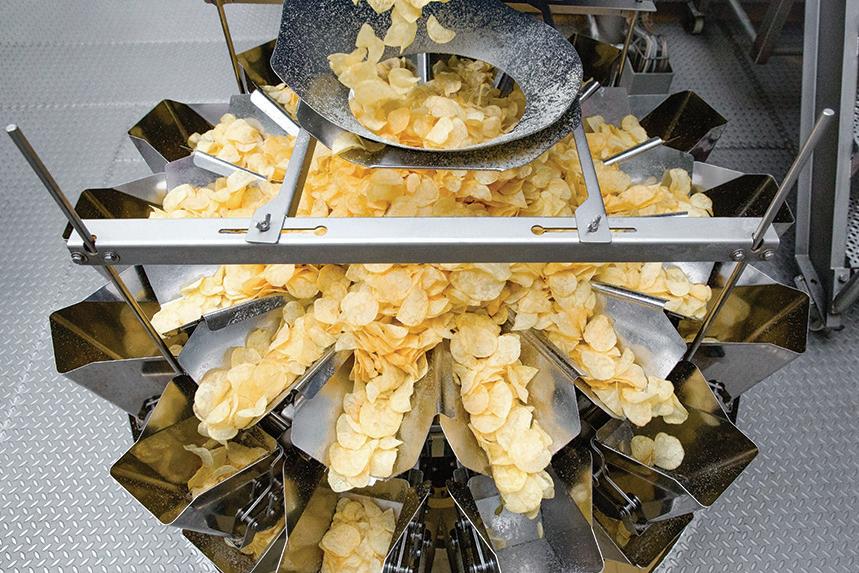
Nov. 3-6, 2024 Booth N-6106 McCormick Place Chicago, IL, USA
info@heatandcontrol.com | heatandcontrol.com
91 97 98 34 17 20 107 36 41 ~2~ 26 LOOKING BACK. PRESSING FORWARD. ALWAYS INNOVATING.
Helping
bring your best products to market.
you



Videojet 1880 + continuous inkjet printer Unlock high-speed performance and precision Discover more at videojet.com/1880+ Featuring an enhanced design and comprehensive connectivity options ©2024 Videojet Technologies Inc. All rights reserved. Videojet Technologies Inc.’s policy is one of continued product improvement. We reserve the right to alter design and/or specifications without notice. 102





16 Seal and Sizzle
Quebec meat processor beefs up its production arsenal with leading-edge vacuum packaging technologies to grow its flagship brand in the retail markets with value-added, case-ready portion packs.
23 Sticking around
Canadian ice-cream stalwart leverages product innovation and packaging excellence to solidify its industry leadership credentials.
30 Cuts and Glory
Canada’s meat industry continues no navigate through tough economic, competitive and regulatory challenges to ensure a healthy future for one of Canada’s most important economic growth drivers.
36 Acing the Test
Globally operating third-party certification and consulting services provider unlocks promising business opportunities in the Canadian market for industrial equipment safety validation and accreditation.
40 Bagging to Differ
Exploring the many surprising sustainability and flexibility advantages of liquid pouch filling technology.
of plastic packging.
44 By Jaan Koel
Joe Public speaks out on packaging hits and misses.
Alpha Meat Packers general manager Terry Tountas cheerfully displays a growing assortment of the company’s premium-quality branded meat products produced on the high-performance MULTIVAC vacuum and skin packing machinery. Cover photography by Pierre Longtin
Gordon Baker
Suite
Return
ON M2H 3R1. No part of the editorial content in this publication may be reprinted without the publisher’s written permission. © 2024 Annex Publishing & Printing Inc. All rights reserved. Opinions expressed in this magazine are not necessarily those of the editor or publisher. No liability is assumed for errors or omissions. All advertising is subject to the publisher’s approval. Such approval does not imply any endorsement of the products or services advertised. Publisher reserves the right to refuse advertising that does not meet the standards of this publication. Printed in Canada. ON THE COVER
Canadian addresses to: Circulation Department,
May 2024 · CANADIANPACKAGING 3 CANADIANPACKAGING.COM May 2024 Vol. 77, No. 4 canadianpackaging.com DEPARTMENTS NEWSPACK 6-8 Packaging news round-up. NOTES & QUOTES 11 Noteworthy industry briefs. FIRST GLANCE 13 New packaging solutions and technologies. ECO-PACK NOW 14 Sustainable packaging innovations. IMPACT 15 A monthly insight from PAC Global. PEOPLE 39 Career moves in the packaging world. EVENTS 39 Upcoming industry functions. COVER STORY
FEATURES
COLUMNS FROM THE EDITOR
CHECKOUT
4 By George Guidoni The Dirty Dozen
16 23 30 ISSN 0008-4654. Canadian
is published 10 times per year
Annex Business Media. Canada Post Publications
40065710.
Packaging
by
Mail Agreement No.
undeliverable
111
Rd.,
400, Toronto,
Calling out the Dirty Dozen of problematic plastic packaging
Ever since checkout plastic bags have been banned from the vast majority of Canadian grocery stores and many other retail outlets, the movement for banning all packaging plastics altogether has been getting a lot of traction among consumers and governments alike.
978,00
tonnes of plastic packging waste generated through residential recycling systems and waste management initiatives in 2022
While seemingly noble in principle and on the surface, the anti-plastic crusade overlooks many of the positive benefits that certain plastic packaging products provide in terms of product protection, shelf-life extension and food waste reduction, where the downside of outright plastic elimination can have huge negative implications for consumer welfare, economic prosperity and food security on an epic global scale.
Being labeled as the world’s chief environmental culprit this century is undoubtedly a very heavy cross to bear, and it takes a lot of courage and self-belief these days to suggest that plastics still have an important role to play in the global packaging industry of today and tomorrow.
Regrettably, such arguments and opinion get remarkably little air play of media coverage compared to the doomand-gloom anti-plastic hysteria dominating the current narrative.
So for the sake of a little balance and fairness, we applaud the efforts by groups like the Canada Plastics Pact (CPP) and the National Zero Waste Council (NZWC) to identify a list of so-called problematic and/or unnecessary plastic packaging products that could be removed from everyday use without long-lasting negative consequences.
Released last month, the new guidance document—titled Supporting the Elimination of Unnecessary & Problematic Plastics—uses a five-step criteria to determine which plastics should be the first to go, including:
• The item or material can be avoided or replaced;
• The item or material contains hazardous chemicals;
• The item or material hinders or disrupts recycling or composting systems;
• The item or material has a high likelihood of being littered.
• The item or material is non-recyclable,
compostable or reusable, and is not likely to be so by 2025.
“Research has shown that single-use items are the most common items found in clean-up efforts in Canada and worldwide,” says CPP’s managing director Cher Mereweather.
“Our latest CPP data reveals that an estimated 978,000 tonnes of plastic packaging waste was produced in 2022 through residential recycling systems and waste management initiatives, with only 20 percent of it being recycled.
“Today’s reality is that many products that are technically recyclable are not collected or processed, and may contaminate other recycling streams.
“It’s clear that the first step we need to take is to eliminate the plastics we don’t need.”
The Unnecessary & Problematic Plastics list includes various items such as checkout bags, cutlery, straws, oxo-degradables, and materials containing intentionally added Per- and Polyfluoroalkyl Substances (PFAS), aka the dreaded ‘Forever Chemicals.’
Other items on the list include stir sticks, beverage six-pack rings, undetectable carbon black, PVC (Polyvinyl Chloride) and|PVDC (Polyvinylidene Chloride), PETG (Polyethylene Terephthalate Glycol), EPS (Expanded Polystyrene), PS (Polystyrene) and multi-material flexibles.
According to CPP, relying solely on recycling systems will not solve Canada’s plastic packaging waste challenges, and that even if industry were to meet all recycling targets it would not be sufficient to eliminate plastic waste entirely.
As Cher points out, “Immediate action is imperative to tackle the challenges posed by plastic waste [and] this document gives industry clarity and direction.
“Keeping plastics in our economy and out of people, animals, and nature is a complex challenge that requires collaboration and innovation at all levels, from all sectors.”
We could not say so better ourselves.

GEORGE GUIDONI, editor GGuidoni@canadianpackaging.com
MAY 2024 | VOLUME 77, NO. 4
Reader Service
Print and digital subscription inquires or changes, please contact Angelita Potal, Customer Service Tel: 416-510-5113
apotal@annexbusinessmedia.com
Mail: 111 Gordon Baker Rd., Suite 400, Toronto, ON M2H 3R1
Senior Publisher Stephen Dean | (416) 510-5198 SDean@canadianpackaging.com
Editor George Guidoni | (416) 510-5227 GGuidoni@canadianpackaging.com
Account Coordinator Barb Comer | (888) 599-2228 ext 210 bcomer@annexbusinessmedia.com
Audience Development Manager Barbara Adelt | (416) 510-5184 Fax: (416) 510-6875 badelt@annexbusinessmedia.com
Media Designer Brooke Shaw | (519) 428-3471 bshaw@annexbusinessmedia.com
CEO Scott Jamieson SJamieson@annexbusinessmedia.com
Annex Business Media 111 Gordon Baker Rd., Suite 400, Toronto, ON M2H 3R1; Tel: 416-442-5600.
Canadian Packaging, established 1947, is published 10 times per year except for occasional combined, expanded or premium issues, which count as two subscription issues.
PRINTED IN CANADA ISSN 008-4654 (PRINT), ISSN 1929-6592 (ONLINE)
PUBLICATIONS MAIL AGREEMENT NO. 40065710
SUBSCRIPTION PRICE PER YEAR (INCLUDING ANNUAL BUYERS’ GUIDE: Canada $80.07 per year,USA $183.09 (CDN) per year, Outside Canada $207.57 (CDN) per year, Single Copy Canada $10.00.
From time to time Canadian Packaging will mail information on behalf of industry-related groups whose products and services we believe may be of interest to you. If you prefer not to receive this information, please contact our circulation department in any of the four ways listed above.
Annex Privacy Officer
Privacy@annexbusinessmedia.com
Phone: 800-668-2374
DISCLAIMER: No part of the editorial content of this publication may be reprinted without the publisher’s written permission. ©2024 Annex Publishing & Printing Inc. All rights reserved. This publication is for informational purposes only. The content and “expert” advice presented are not intended as a substitute for informed professional engineering advice. You should not act on information contained in this publication without seeking specific advice from qualified engineering professionals. Canadian Packaging accepts no responsibility or liability for claims made for any product or service reported or advertised in this issue. Canadian Packaging receives unsolicited materials, (including letters to the editor, press releases, promotional items and images) from time to time. Canadian Packaging, its affiliates and assignees may use, reproduce, publish, republish, distribute, store and archive such unsolicited submissions in whole or in part in any form or medium whatsoever, without compensation of any sort.
We acknowledge the [financial] support of the Government of Canada
4 CANADIANPACKAGING · May 2024
FROM THE EDITOR

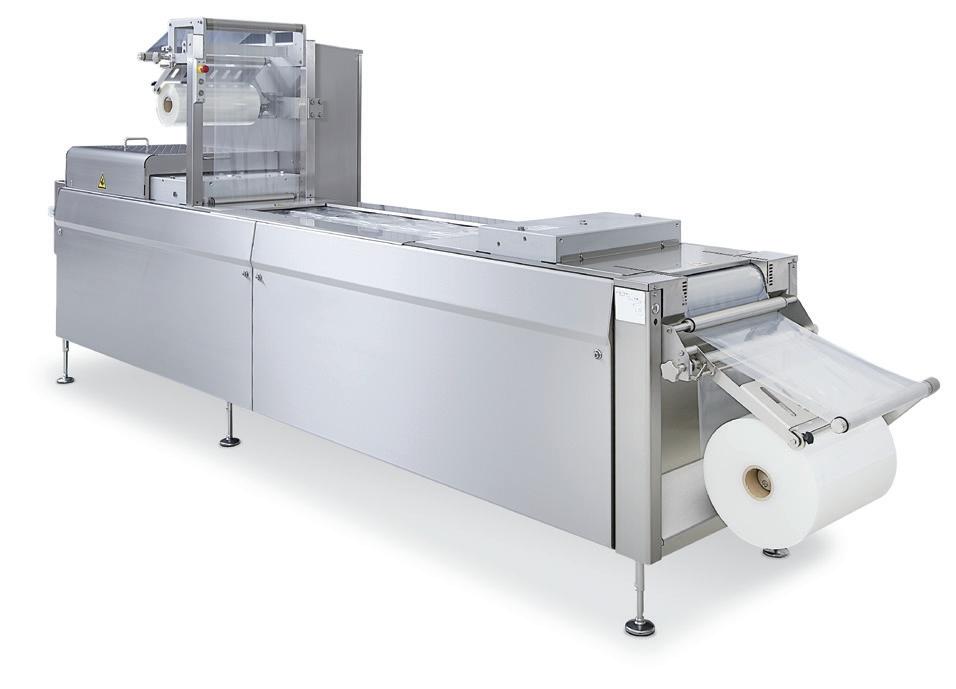
Reiser Form/Fill/Seal Packaging Machines
Wide range of flexible machines produce high-quality VSP, MAP, and vacuum packages
High-speed production
Superior seals eliminate leakers and returns
Backed by Reiser’s industry-leading service and support Take your business to the next level with Reiser packaging Extend product shelf life with superior packaging technology from Reiser Watch video 2023 www.reiser.com Reiser Canada • Burlington, ON • (905) 631- 6 611 Reiser • Canton, MA • (781) 821-1290 Reiser UK • Milton Keynes, Bucks • ( 019 08) 585300
n
n
n
n


New Sprite flavor offers cool thirst relief to beat the coming summer heat
With scorching summer heat now just around the corner, The Coca-Cola Company is betting that its new limited-time edition version of the company’s iconic brand Sprite has exactly what it takes to help Canadians chill out in perfectly good taste.
Launched across Canada last month, the new Sprite Chill and Sprite Chill Zero Sugar add a deliciously refreshing twist of cherry-lime to the brand’s signature lemon-lime taste, accentuated by a proprietary blend of
cooling agents to deliver a uniquely elevated sensory experience.
“Sprite understands that people’s lifestyles and tastes are ever-changing, and the introduction of Sprite Chill is just one way that the brand is innovating to keep pace with its consumers and deliver on a unique beverage experience,” says Jacques Blanchet, director of integrated marketing at The Coca-Cola Company.
“This limited-time-only beverage amplifies the refreshing flavour Sprite fans love with a cooling sensation that intensifies with every sip. Prepare to get chills!”
As Blanchet relates, The Coca-Cola Company’s R&D team went through several rounds of development and testing before landing on the optimal ratio of cherry-lime flavour and cooling intensity—making sure the beverage deliver waves of refreshment, with the cooling sensation building from the first sip to the last.
While similar technology is used in confectionery and baking, Sprite Chill is the first-ever sparkling soft-drink to deliver a cooling sensation without an accompanying mint flavor.

“Consumers today are looking for multisensorial beverage experiences, so we saw a unique opportunity to elevate the crisp, refreshing taste Sprite fans expect with a first-of-itskind cooling sensation,” said Felicity Boucetla, Coca-Cola’s senior director of product development for sparkling flavors.
Available in individual 500-ml bottles, as well as 12-packs of 355- m l cans and six-packs of 222-ml cans— and also in 12-packs of 355-ml cans for Sprite Chill Zero Sugar—the brand’s eye-catching packaging combines an icy blue and frosted cherry color palette with jagged iceberg-inspired graphics.
“The packaging for Sprite Chill was designed by our North American team who localized it for the Canadian market, following all local rules and regulations,” Blanchet relates.
“The design is intended evoke the feeling of the intensified cooling sensation and flavor that Sprite Chill delivers,” he adds.
“The details are reflective of jagged ice to graphically represent the icy chill, flavor change and cut-

through refreshment that Sprite Chill brings forward,” Blanchet states.
“This was a fun creative brief to work on because Sprite Chill is an intrinsic-led innovation platform,” adds A.P. Chaney, senior creative director for sparkling flavors.
“The cooling sensation technology inspired us to lean in to the ‘ice-cold’ colloquialism, a cultural double-entendre for Gen Z consumers that implies being at the top of your game.”
Made and packaged by Coca-Cola Canada Bottling Limited , an independent, family-owned business operating five bottling facilities across Canada, the new soda is a follow-up to recent successful limited-time launch es of Sprite Lymonade Legacy and Sprite Winter Spiced Cranberry
“We’re aware that people’s taste preferences and lifestyles are changing, so we’re evolving our brand to meet those needs,” Blanchet says.
“Cherry-lime adds a refreshing taste to the brand’s signature lemon-lime flavor and it marks a first for Sprite Chill: a soft-drink that delivers a cooling sensation that isn’t accompanied by a mint flavor. “
Conveyor Models









NEWSPACK
at Your Fingertips Customize and download conveyor models in minutes with mk’s CAD360. Belt Conveyor Roller Conveyors Timing Belt Conveyors Flat Top Chain Conveyors Individual conveyors and entire conveyor systems. Registration is FAST and FREE!


Canadian print stalwart keeps raising the bar with automation investments
Calling Cober Solutions a jack of all trades would be missing the point for a venerable Canadian print services provider that’s still growing from strength to strength after more than 100 years in the print business.
Headquartered in Kitchener, Ont., the family-owned print specialist is more like a Swiss army
knife, boasting extensive industry experience and a vast production arsenal enabling it to turn out high-quality products ranging from packaging and retail displays to commercial print and large-format signage.
Built on the foundation of innovation and print, Cober has continuously embraced change and technology to serve its clients, with recent investment in state-ofthe-art equipment from renowned
press manufacturer Heidelberger Druckmaschinen underscoring the company’s growth-driven investment philosophy.
Aiming to boost productivity for smaller-volume print runs, Cober has recently commissioned two Canadian ‘firsts,’ including the Speedmaster XL 106-8P press with a patented Plate-toUnit system and a new robotic P-Stacker for its Stahlfolder TH 82 automatic folding machine with a PFX feeder.
Installed to eliminate bottlenecks in Cober’s plate-making process, Heidelberg’s Plate-to-Unit is a fully-automatic printing plate logistics solution designed to reduce operator workload and ensure higher process reliability, whereby the printing plates are automatically placed in and removed from the correct platechanging shaft without operator intervention.

“After using Plate-to-Unit for a couple of months, I couldn’t imagine buying a press without this functionality,” he states. “It has become a game-changer.”
For its part, the new Stahlfolder TH 82 folding machine with PFX Feeder and new P-Stacker has replaced two older buckle folders, and it is used exclusively for folding the company’s 16-page signatures.
As Cober explains, the PFX Feeder is designed to feed sheets like the feeder of a printing press, whereby the sheets are shingled and underlapped in the first folding unit.
The underlapping of sheets (shingling sheets) on the infeed register table nearly doubles the number of sheets that can be processed compared to conventional sheet-gap feeding at the same running speed.
“With our older stream-fed folders, we would have three people running two folders,” Cober points out.
The system has enabled Cober to consistently achieve two-minute make-readies “without burning out its crew,” according to company president Todd Cober. 24_002896_CN_Pckg_MAY_CN Mod: March 29, 2024 3:45 PM Print: 04/12/24 page 1 v2.5
“Now it’s one person on one folder—at twice the speed.”





8 CANADIANPACKAGING · May 2024 CANADIANPACKAGING.COM NEWSPACK
ORDER BY 6 PM FOR SAME DAY SHIPPING π
SUPPLY SPECIALISTS COMPLETE CATALOG 1-800-295-5510 uline.ca SAFETY PRODUCTS ALWAYS IN STOCK IN ALL LOCATIONS CPK_Uline_May24_CSA.indd 1 2024-04-17 9:49 AM
SHIPPING
From left: Cober Solutions press operator Jonathan Walsh, lead hand Joe Bain, and director of operations Sam Mueller in front of the Stahlfolder TH 82 and P-Stacker from Heildelberg.









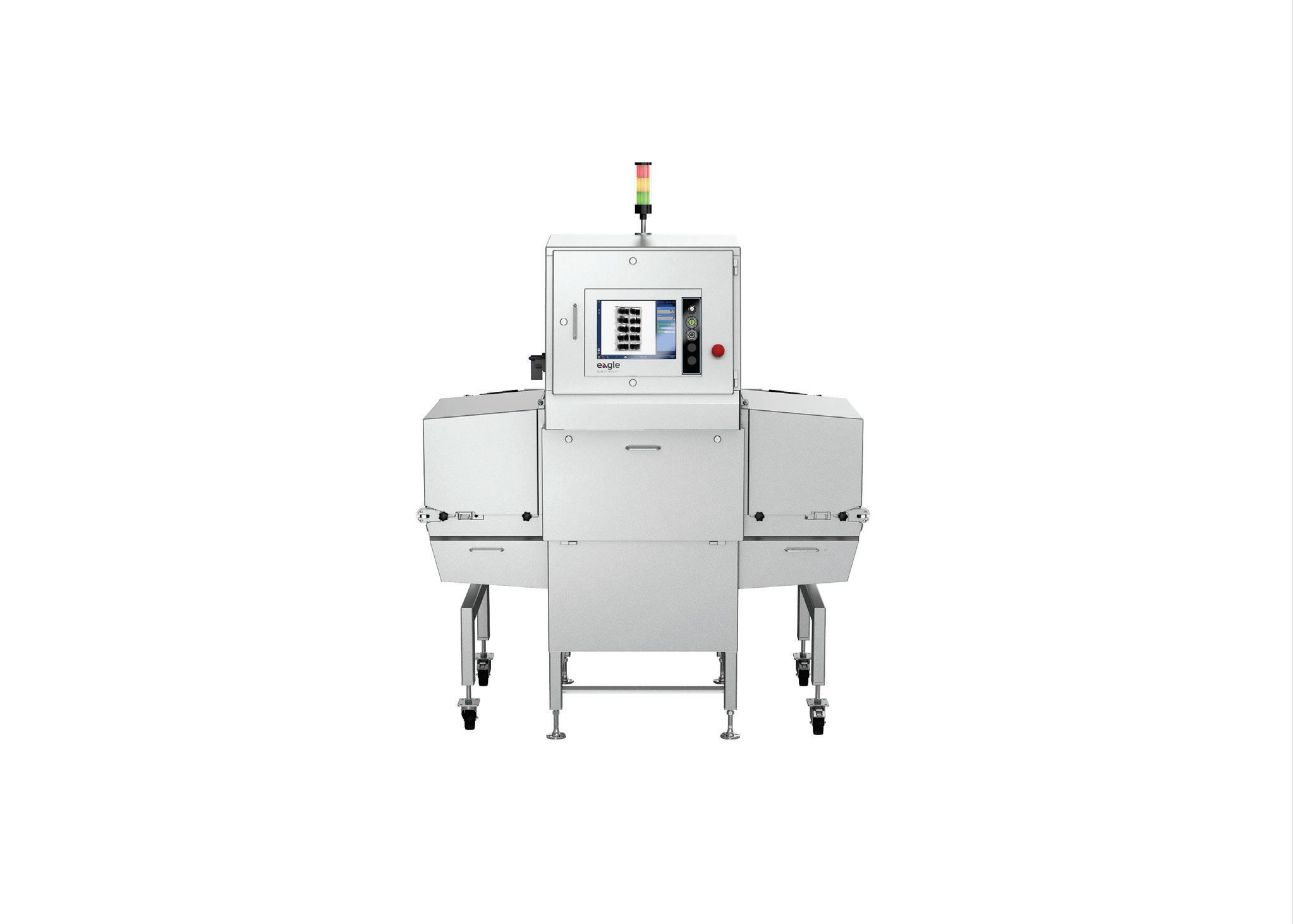


SUSPECT FOREIGN MATERIALS X-RAY INSPECT & RECOVERY 3rd Party Rework Services for Food Products OFFSITE INSPECTION • x-ray inspection of finished food products • metals, bones, stones, glass, aluminum, rubbers, plastic, and standard foreign bodies • mobile services Contact 1-844-XRAY-911 (9729) INSPECTION & RECOVERY PARTNER FOR FOOD PROCESSORS xrayreclaim.com | info@xrayreclaim.com | 5 Loring Drive Bolton, ON L7E 1Y1 Separation identification of bolt Identified foreign body: Single 1 inch long Stainless-Steel Bolt
foreign body: Steel
Failure Identified foreign body: Calcified hollow chicken bone Chicken Bone: 22 x 7 x 2.4mm
Identified
Shaving from Auger


From Left: MG Tech general director Xavier Lucas; Premier Tech Systems and Automation president and CEO André Noreau; MG Tech president Eric Gautier; Simon Roy, president and chief operating officer at Premier Tech Systems and Automation; Jean Bélanger, president and chief executive officer at Premier Tech.
Premier Tech , Rivière-du-Loup, Que-headquartered manufacturer of automated machinery for agricultural and horticultural industry applications, has entered into a strategic partnership with MG Tech Group of Les Achards, France, for joint marketing and distribution of the two companies’ respective packaging technologies for manufacturing applications in the nutritional, industrial, fast-moving consumer goods and parapharmacy industries. According to MG Tech, the addition of Premier Tech to MG Tech’s portfolio will allow the French group to fully leverage the global ecosystem of Premier Tech Systems and Automation and access an extensive network of products, services and technologies to support its growth in North American and international markets. “With the integration of Premier Tech Systems and Automation to the MG Tech ecosystem, we will expand our footprint and further open ourselves to the world,” says MG Tech president Gautier. “The establishment of our subsidiary in Canada confirmed that our end-of-line packaging equipment is perfectly designed for the North American market,” Gautier adds. “We will come up, alongside Premier Tech, with new services and continue our international expansion.” According to Simon Roy, president and chief operating officer of Premier Tech Systems and Automation, “This partnership opens the door to the global expansion of our secondary packaging operations, previously centred in North America, by setting the development of market segments with a broader range of products such as leading-edge case erectors and robotic case-packers. Joining forces allows us to harness complementary strategic skills, delivering more value to our clients.”

Headquartered in Washington, D.C., the former North American Meat Institute has announced the official change of the venerable association’s name to Meat Institute, while also unveiling a new logo and brand identity to better reflect its dynamic, forward-looking approach to ensuring that meat remains at the heart of nourishing the present and sustaining the future generations. Evoking the shape of a plate and featuring an open frame indicating transparency and inclu-
siveness, the new logo intends to project a sense of movement—signaling constant evolution and pursuit of continuous improvement—while the new dark blue primary logo colors also include an energetic pastel blue and a modern orange accent that serves as an updated nod to the association’s previous maroon brand. “Sustaining meat’s future is central to the Meat Institutes’s mission and vision, building on our 120 years of leadership and meat’s centuries of contributions to healthy diets and strong communities,” says Meat Institute’s president and chief executive officer Julie Anna Potts. “Our updated logo is fresh, open, and keeps meat at the very center of nourishing today and sustaining tomorrow.”
Winnipeg-headquartered flexible packaging product group Winpak Ltd. has received an A- score in the company’s recently concluded the 2023 Carbon Disclosure Project (CDP) assessment, a globally recognized initiative that evaluates and scores companies based on their efforts to mitigate climate change, manage environmental risks, and operate sustainably. “Our A- score places us in the CDP leadership category and in the top 18 per cent of disclosers for plastic product manufacturing,” says Phillip Crowder, Winpak’s director of corporate sustainability. “This leadership level is a testament to the hard work of every member of our organization and our collective efforts to make a positive impact on the planet.”

Leading global packaging products group Amcor has announced plans for a major expansion of its North American printing and converting capabilities for the dairy market to support customers’ demand for flexible packaging solutions. According to Amcor, the installation of new state-of-the art equipment over the next 18 months—primarily in Wisconsin—will expand and optimize local manufacturing capacity, while also support the planned conversion to more sustainable packaging. “Amcor is committed to deliver innovation, service flexibility and agility that will ultimately enhance our customers’ experience,” says Derrick Sytsma, vice-president and general manager for dairy business at the Amcor Flexibles North America headquarters in Oshkosh, Wis. “This strategic investment represents the largest of its kind in Amcor Flexible North America’s extensive history within the cheese business, which solidifies our commitment to the dairy industry, as well as our continued support of our customers’ growth.”




May 2024 · CANADIANPACKAGING 11
NOTES & QUOTES The new Hitachi UX2 InkJet Printer-Developed for Tomorrow’s production line Call us today for more details or to book a demonstration 1-877-427-5863 sales@harlund.com www.harlund.com QUICK CHANGE CONNECTORS ON BOARD VIDEO GUIDANCE CLEARER CODES & FASTER SPEEDS LONGER PRINTING CYCLES FIRST IN INDUSTRY SAFE PRINTHEAD CLEAN STATION CPK_HARLUND_SQ_OCT23_MLD.indd 1 2023-09-26 1:50 PM










www.vc999.com · 877-435-4555 · Sales.Canada@VC999.com SMALL BUT MIGHTY OUR NEW COMPACT ROLLSTOCK THERMOFORMER Let VC999 help you create the perfect packaging solution! - www.VC999.com WE’VE PACKED THE FUNCTIONALITY OF A MUCH LARGER THERMOFORMING MACHINE INTO A COMPACT MACHINE ONLY 12 FOOT LONG. • Durable • Efficient • Small Footprint




FASTER WITH FESTO
The new heavy-duty Cartesian gantry robot for palletizing applications from Festo features robust lift capacity of up to 200 kilograms, along with Z-axis stroke lengths exceeding eight feet and speeds of up to five feet per second. With free online design tools, off-the-shelf servo drives, motors, and other components, and quick-assembly kits, this palletizing solution shortens project time and reduces engineering and assembly costs, according to Festo. The new palletizing solution incorporates robust, high-rigidity electric actuators at the core of the system, including the tough cantilevered Z-axis EHMH rack and pinion actuator for loads up to 200-kg; the ELCC toothed belt actuator with ball bearing guides for loads up to 100-kg; and the Festo EGC-HD heavy-duty toothed belt or ball screw actuator for the X-axis. Offering a lower-cost alternative to six-axis robotic palletizers, along with superior accuracy and speeds whether handling a small load over a long reach or a heavy load over short distances, this Cartesian robot is claimed to be the ideal solution for most heavy-duty applications. Unlike six-axis robots that lose accuracy and lift capacity at the periphery, the gantries cover the entire workspace with equal accuracy, speed and performance at each point on the X/Y axes, while also providing a smaller footprint to fit into today’s smaller and more compact operations. Festo Inc.

PERFECT SENSE
The three new series of M12 capacitive sensors with IO-Link communications from Carlo Gavazzi are designed to provide an ideal solution for industrial automation equipment in applications where sensing performance must be continuously and accurately monitored and logged, such as semiconductor
and printing applications requiring high-precision detection of different-sized objects, shapes, and dielectric values. Based on the company’s fourth-generation TRIPLESHIELD brand sensors, these sensors have been designed to flexibly adapt to industrial applications with a choice of housing options, including: PBT for less challenging environments;l AISI316L stainless steel for strength; and PEEK polymer, offering a smooth surface to reduce accumulation of dust or liquids. In addition to the full range of technical features provided by this capacitive sensor upgrade, the IO-Link communication allows additional advanced data such as: QoR (Quality of Run), QoT (Quality of Teach), temperature and dust alarms, and diagnostic parameters—facilitating timely scheduling of predictive maintenance procedures for maximum equipment uptime.
CARLO GAVAZZI
(Canada) Inc.
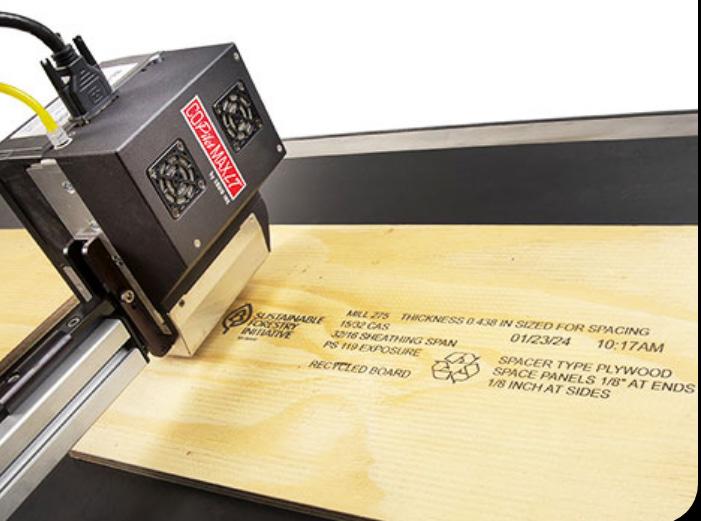
THE LONG THROW
The new CoPilot Max LT long throw printing system from Squid Ink Manufacturing features 2.8-inch print height per printhead, print speed of up to 440 feet per minute, up to a half-inch throw distance, and the capability to run two printheads from one controller. Offering a highly versatile and cost-effective solution for a broad range or product marking and coding applications, CoPilot Max LT’s increased throw distance makes the printing system a very efficient solution for users to make their mark on overfilled cases, angled or recessed surfaces, irregular-shaped products, or product lines with inconsistent handling. In addition, the CoPilot Max LT printing system is designed to print superior-quality, high-resolution characters on porous or non-porous surfaces, along with the capability to run UV LED curable inks for applications that require instant dry times on non-porous surfaces. Moreover, CoPilot Max LT utilizes Squid Ink’s innovative active ink system to enable users to tilt or rotate the printhead in any direction without making height adjustments to the system’s 500-ml ink cartridge.
Squid Ink Manufacturing

NATURAL FLOW
With an eye on packaging sustainability, Theegarten-Pactec has recently re-engineered its FPC5 high-speed packaging machine for chocolate bars to enable it to process paper-based flow-packs using the conventional cold-sealing process, as well as in the more complex heat-sealing process. Now capable of producing flow-pack packaging with integrated heat-seal capability and a pure paper content of at least 95 per cent, the FPC5 can achieve high processing speeds of 100 meters per minute for paperbased packaging—thanks to reduced sealing time achieved by pre-heating the seal area during the wrapping material unwinding process. According to the company, this significantly reduces the required duration of heat application by the sealing tools to the packaging—thereby avoiding damage to the packaging and the product as they glide smoothly through the machine.
Theegarten-Pactec

FIRING ALL CANONS
The new Flexi 22 software suite from SA International (Sai) is an all-in-one design, print and cut software for sign and print providers now offers compatibility with Canon’s entire UVgel roll-to-roll printer range, including both the both the Colorado 1600 series and the newly introduced Colorado M-series printers. Incorporating new drivers and supporting both white and multilayer printing, the Flexi 22 software drivers also includes Canon’s FLXfinish+ technology, which enables customers to print matte, gloss or mixed matte and gloss on the same print, without the need for additional varnish. Capable of driving up to five printers simultaneously and any number of cutters, Flexi 22 offers a complete solution for designing, printing, cutting and print-and-cut, lever-
aging built-in 64-bit RIP architecture to ensure optimal performance and precision in advanced color management, spot color mapping, Pantone matching, true-shape nesting, and banner finishing.
SA International
OPEN & SHUT CASE

The new LDX-RTB Premier semi-automatic random case sealer from Signode is designed to provide superior flexibility in processing a large range of case sizes and fill levels at high speeds, while minimizing downtime. With belt speeds of up to 155 feet per minute, the LDX-RTB Premier case sealer is especially well-suited for fast-paced environments like e-commerce and retail with value-added features that include: correlating CaseLocker series tape cartridges, each featuring a patented locking knife guard system for pinch point prevention; pneumatic assist for highspeed operation; and a simplified threading path for quick and easy tape loading.
Signode

CUT TO THE CHASE
Developed for industrial applications demanding utmost accuracy and precision, the new Kongsberg C68 Exact larger-format digital drawing and light cutting machine from Kongsberg PCS delivers high-quality drawing and plotting with fiber or ball point pen tools on paper and other smooth surfaces. With a special vacuum drilling pattern and smooth surface treatment, the tabletop facilitates extra-precise drawing and light cutting. Based on the powerful market-leading Kongsberg C platform of cutting tables, the Kongsberg C68 Exact is capable of precisely cutting paperbased materials, plastics, or other flexible materials—including masking films, polyester sheets, PVC films and flexible foils—over surface area measuring 3,210 x 6,400-mm. Kongsberg PCS
May 2024 · CANADIANPACKAGING 13 CANADIANPACKAGING.COM
FIRST GLANCE
Moving Beyond Plastic
Unwrapping the multiple benefits of paperboard packaging for fresh produce
By Louis Lemaire
The fresh produce sector has always been a hotbed of innovation. One only needs to look at the advent of canning in the 19th Century, the adoption of refrigerated trucks and train carriages in the 1920s and ’30s, and the way the industry has embraced e-commerce and digitalization to facilitate the omnichannel market we rely on today.
This legacy of innovation is something we are very proud to carry forward at Graphic Packaging, as we continually strive to develop the next generation of paperboard packaging innovations.
Today the fresh produce sector faces a new set of challenges, as it becomes increasingly clear that heavy reliance on plastic packaging cannot continue.
Paperboard packaging is well-placed to provide a solution to this challenge, combining the barrier performance of traditional plastic solutions alongside improved recyclability and being made from renewable raw materials.
By now most Canadians are well aware of the federal government’s ‘Zero Plastic Waste Agenda,’ a series of measures aimed at banning or disincentivizing many categories of plastics, while promoting the use of recycled or recyclable materials.
While the legislative landscape remains uncertain, the minds of Canadian consumers are anything but.
A 2021 study found that over 93 percent of Canadians were personally motivated to reduce their consumption of single-use plastic food packaging, while many retailers were also exploring ways they can minimize or eliminate plastic packaging in their fresh produce aisles .
By any measure, paperboard packaging is more closely aligned with the vision of Canadian consumers, retailers and regulators, with the vast difference between paper and plastic recycling rates emphasizing this point further.
Almost 70 per cent of all paper and paper-based packaging is recycled to-


Graphic Packaging manufactures a broad range of highly attractive and practical paperboard packaging solutions for many types of fresh produce, helping to reduce the industry’s reliance on plastic packaging without compromising product protection and shelf-life properties.
day—positioning Canada as one of the world leaders in its recovery—whereas only nine per cent of plastic waste is recycled .
While there is a strong focus on plastic reduction, this trend must be balanced with robust product protection and shelf-life preservation.
This is particularly important in Canada, where the short growing season means that much of its fresh produce has to be imported.
Any business looking to reduce the overall carbon footprint of its operations should view limiting food waste as a mission-critical imperative.
Globally, food waste has a much greater emissions profile than plastic waste, so eliminating plastic can be counter-productive if it results in pack aging that delivers compromised performance.
For some applications, it is now possible to develop paperboard packaging solutions that do not contain any plastic, without negatively impacting product preservation.
Our recent collaboration with BelleHarvest, a major U.S.-based apple grower, provide powerful evidence to this capability.
We worked with the grower to create a recyclable paperboard carton to replace a flexible plastic pack that led to a
15-percent reduction in apple defects due to bruising.
We acknowledge that there is no onesize-fits-all solution for fresh produce, and that a 100-percent paperboard solution may not be viable for some applications that have more complex barrier needs, such as berries.
However, plastic content can still be minimized, for example, by moving from a flow-wrapped to a top-sealed tray.
For applications requiring modified atmosphere, such as prepared fruit, trays that combine a paperboard base with a barrier liner can be readily adopted—offering up to a 90-percent reduction in plastic, but still offering an equivalent shelf-life.
Functional performance is not the only area that growers and packers must consider, as operational efficiency should ideally match that offered by plastic solutions.
Paperboard solutions can be tailored for both hand- or machine-packing, and businesses can often transition from plastic to paperboard packaging with minimal, or even no new machinery investment.
Even when dealing with chilled packing environments, paperboard-based solutions like the ProducePack punnet trays show that it is possible to augment paperboard materials with water-based barrier coatings that offer protection against moisture in high-humidity environments.
Because a pack’s aesthetic design will continue to play a role in a consumer’s purchasing decisions, paperboard offers many unique many structural and graphic design possibilities—unlocking new opportunities for creating great onshelf differentiation.
Transitioning to paperboard packaging offers growers and fresh produce companies many benefits.
Canadian consumers strongly support its use, the federal government is strongly committed to reducing plastic packaging, and operational efficiency and product shelf-life no longer need to be compromised.
So what better time to make the switch than now?

LOUIS LEMAIRE is the director of sales at Graphic Packaging Canada, the Canadian subsidiary of globally-operating consumer packaging producer Graphic Packaging Holding Company, headquartered in Atlanta, Ga.
14 CANADIANPACKAGING · May 2024 CANADIANPACKAGING.COM
ECO-PACK NOW





SUMMIT2024
Get inspired by Futures Edge sustainable innovations for the packaging value chain: flexible packaging disruptors and coatings in response to the call for the Golden Design Rules, sustainable digital workflow, printing and connected processes, RFID and end-to-end automation, reusable/refillable landscape, and fibre-based packaging alternatives. Keynote Disruptors Keynote Disruptors
Disruptor Lineup
Disruptor Lineup












 Vlad Rebellon Sr. Director, Loblaw Brands
Vlad Rebellon Sr. Director, Loblaw Brands
 Tom Szaky Founder & CEO, Terracycle & Loop
Tom Szaky Founder & CEO, Terracycle & Loop
 Kent Wootton Manager of Circular Materials Innovations Canadian Tire Corporation
Kent Wootton Manager of Circular Materials Innovations Canadian Tire Corporation
2024
REGISTER NOW FOR DISRUPTORS SUMMIT AT BARRETT CENTRE FOR TECHNOLOGY INNOVATION, TORONTO, CANADA ON JUNE 11, 2024 @ PAC.GLOBAL/DISRUPTORS-SUMMIT-2024/
2024

SEAL TO SIZZLE
Montreal meat processor puts itself on fast track for growth in retail space with state-of-the-art vacuum and skin packaging technologies
By Andrew Snook
Photos by Pierre Longtin
Alpha Meat Packers started out with humble beginnings in 1970 as a small butcher shop in old Montreal
Fast-forward to today, and the company operates a 28,000-square-foot facility servicing major retailers and foodservice companies as a secondary processor and packer of a wide variety of meat products.
The company acquires raw meats and processes them into finished goods, specializing in portion cutting, generic packaging, and in-house or private label packaging.
“There was a growing need at the retail level and at the foodservice levels to
provide portions and portion control,” explains Terry Tountas, general manager of Alpha Meat Packers, whose father founded the company 54 years ago.
“Major retailers are depending upon secondary processors like ourselves to provide value-added, which to them is case-ready packaging.”
The company’s business is split roughly 25/75 between the hospitality and retail segments, with its customer base including restaurants, hotels, cafeterias, convenience stores, smaller grocery stores, and large conventional supermarkets operating under all the major banners.
“Our Alpha brand is strong, especially in foodservice, and it has been strong for a long time,” says Alpha’s director of
16 CANADIANPACKAGING · May 2024 CANADIANPACKAGING.COM
COVER STORY

sales and marketing Peter Koukos.
“Our short-, medium- and long-term plan is to build and develop a stronger presence for our brand in major retail outlets,” he adds.
“What’s most important to our customers today is the attention to detail, quality, collaboration, and the after-sales service.”
Running on year-round basis, the company’s Montreal plant operates one 12-hour shift, five-days-a-week, as well as weekends and overtime when necessary.
Depending on the time of year, Alpha Meat Packers can have upwards of 150 employees in peak season during the summer months, with about 130 staff on average over the course of a year.
In addition to the globally recognized SQF (Safe Quality Food) and the all-important HACCP (Hazard Analysis and Critical Control Points) certifications, Alpha also boasts the Halal certification from ISNA Canada, validating the company’s credentials for producing meat products in accordance with Islamic dietary guidelines.
“What’s most important to our customers today is the attention to detail, quality, collaboration, and the after-sales service.”
Says Koukos: “We have a robust food safety improvement program to analyze and control critical points to ensure that our product is prepared under hygienic conditions, is safe for consumption, and generates minimal waste.
“Moreover, we are currently working on and pursuing an extended producer responsibility program (EPR) for our packaging, which we hope to have fully operational by 2028,” Koukos says.
As Koukos relates, the demand for Alpha Meat Packers’ products has grown exponentially in recent years, with its most popular offerings comprising a wide assortment of chicken, beef and pork products.
According to Koukos, the company’s beef burgers are undoubtedly its most popular product line, as evidenced by the approximately 5,000 pounds of ground beef processed at the plant on a daily basis.
To keep up with the growing demand while optimizing its production process, Alpha has recently made a major capital investment in technologically advanced packaging machinery manufactured by MULTIVAC, namely the model R126 thermoforming packaging machine and the model R275 MultiFresh vacuum skin packaging system.
“These latest additions have significantly enhanced our production efficiency, leading to a notable reduction in costs,” says Alpha’s director of maintenance Éric Boivin.
“Furthermore, they have played a pivotal role in addressing personnel challenges, streamlining our workflow, and enabling us to offer premium products to our customers, thereby elevating their satisfaction and loyalty.”
As Boivin relates, the company was quickly impressed with the flexibility and throughput speed of R126 thermo-

May 2024 · CANADIANPACKAGING 17 CANADIANPACKAGING.COM
Below Alpha Meat Packers sales and marketing manager Peter Koukos (left) and maintenance manager Éric Boivin inspecting seal and label quality on a package of pork chops processed on the MULTIVAC R275 skin-packer.




forming packaging system.
“We are consistently achieving 10 cycles per minute with products that are ready to be packed directly after exiting the machine—significantly enhancing our efficiencies and allowing us to reduce our staffing requirements,” Boivin relates.
“This achievement not only streamlines our production process, but it also optimizes our operational costs—contributing to an overall increase in productivity and resource allocation.”
Adds Tountas: “That machine alone has been a real growth driver for us.
“I’d say we’ve had maybe 40-per-cent growth on that line right now, which has us thinking of purchasing a second one.”
According to Tountas, the R126 thermoforming packaging system has also enhanced the quality and popularity
of the company’s line of marinated beef products.
As he explains, “The aging process is still taking affect, along with the tenderizing process, through the marinade [after packaging].
“The longer we keep these products entirely vacuum-sealed, the more we’re actually increasing its quality over time,” Tountas states.
This new investment was not the first time that Alpha has made a major purchase from MULTIVAC, says Boivin, recalling a much earlier installation of a MULTIVAC R120 thermoforming packaging machine and a C500 vacuum sealer that have both delivered outstanding service and reliability.
“We began working with MULTIVAC in 2010,” Boivin relates, “choosing them for their competitive prices and value.
18 CANADIANPACKAGING · May 2024 CANADIANPACKAGING.COM COVER STORY
From Left: Alpha’s maintenance manager Éric Boivin, MULTIVAC Canada’s senior account manager Denis Poulin, and Alpha’s sales and marketing manager Peter Koukos.
Machine operator placing portioned cuts of marinated beef inside the film-line cavities of the MULTIVAC R126 thermoforming packaging machine prior to the next run.
Close-up of the user-friendly HMI panel used to control and monitor operations of the R126 thermoforming packaging machine.
Close-up of marinated beef cuts placed inside the film-lined cavities of the MULTIVAC R126 thermoforming packaging machine.



“Their excellent customer service and the ability to provide equipment tailored to our needs have further confirmed our choice.”
“More recently, their excellent customer service and the ability to provide equipment tailored to our needs have further confirmed our choice,” Boivin says.
As Koukos points out, investing in automation for the packaging line has been vital for enabling Alpha to manage its operational costs and remaining competitive.
“We understand the efficiencies that come with automation and the impact it has, like speeding up production, re-
ducing operational costs, and having the agility to meet customers’ varied demands,” Koukos states. “This is undeniable.
“Despite its advantages, it also comes with its challenges, such as integration, adaptation, compliance, and employee training.
“But all and all, Alpha Meat has really embraced this technology,” Koukos asserts, citing the plethora of value-added performance features provided by MULTIVAC machinery, epsecially the
R275 MultiFresh (MF) skin-packer.
Made in Germany, the R275 MF thermoforming packaging machine enables the production of MultiFresh vacuum skin packaging in large batches. With maximum depth of draw of 150mm, it offers a great degree of variability with regard to MultiFresh applications— including MAP (modified atmosphere packaging)—producing attractive, consumer-friendly packages with extended shelf-life properties and optimal product protection.
Full view of the high-performance MULTIVAC R126 thermoforming packaging machine.
Close-up of the roll of Alpha brand labels inserted onto the R126 machine’s on-board labelling system.
The Alpha brand bavette steak packaged on the MULTIVAC R126 thermoforming packer.
May 2024 · CANADIANPACKAGING 19 CANADIANPACKAGING.COM
Clockwise from left
Full view of the MULTIVAC R275
MF

A high-efficieny Busch vacuum pump generating suction for the
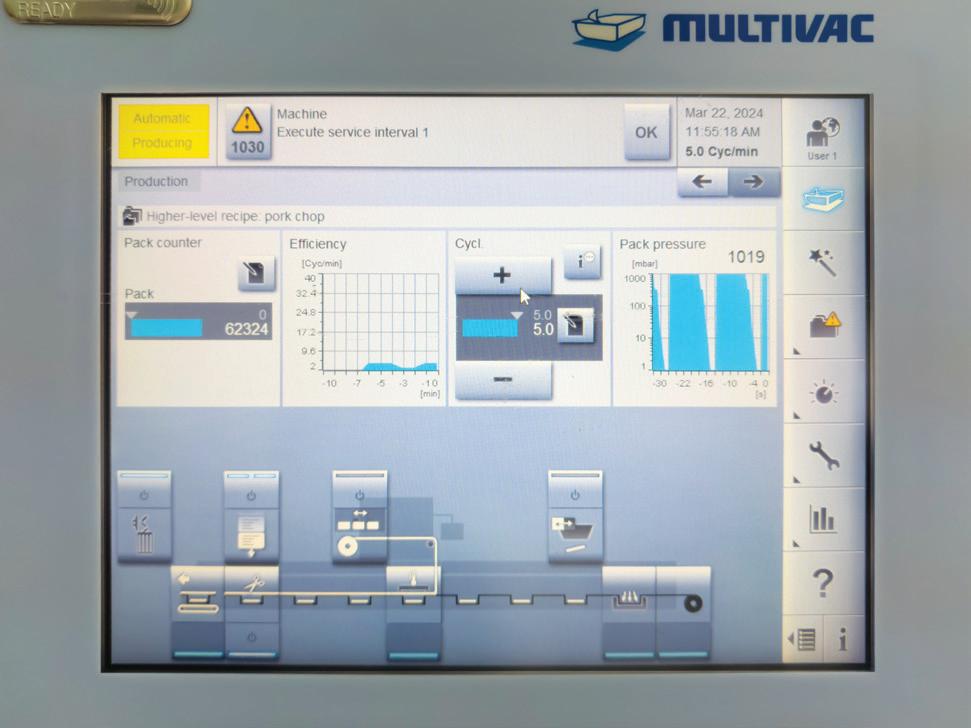
As Boivin further points out, “The Busch R5 RA 0630 C pump that connects to the MULTIVAC R275 MF skin packaging machine and is a real workhorse.
“It’s a very powerful pump that enables proper performance of the machine due to its size.”
One of the key advantages that the MULTIVAC R126 and R275 MultiFresh vacuum skin packaging machine have provided for the Alpha Meat Packers packaging department is the complete automation of its labeling operations.
“We installed a top and bottom labeler and printer on the two machines, so now they don’t need anybody putting labels on by hand on any packs at all,” says Denis Poulin, senior account manager with MULTIVAC Canada
“They don’t have anybody with a hand applicator putting dates on it: it’s all done automatically on the package coming

out of the line.
“And it’s a great looking package,” he extols, recalling how the Alpha Meat Packers team was impressed by the commissioning process of both machines.
“The delivery and installation process were seamless, marked by excellent communication with our maintenance department,” Boivin says. “The training provided was thorough and well-executed, enabling our staff to achieve automation relatively quickly,” he points out.
“This efficient approach ensured a smooth transition and integration of the new systems into our operations—significantly enhancing our team’s capability and confidence in managing the new equipment.”
Boivin notes that training the plant’s staff on the two new machines was made significantly simpler through MULTI-
20 CANADIANPACKAGING · May 2024 CANADIANPACKAGING.COM
From left
Close-up of the user-friendly HMI panel controlling the R275 system’s operation.
R275 skin-packer.
COVER STORY
vacuum skin-packing machine recently installed at the Alpha Meat Packers production facility in Montreal.
VAC’s human-machine interface (HMI) terminals.
“Their human-machine interface is remarkably intuitive,” he enthuses, “simplifying the navigation through menus and significantly enhancing the user experience.
“This ease-of-use not only streamlines our production process, but also reduces training time and increases operational efficiency,” Boivin says.
Another advantage of the two new machines is their ability to seamlessly transition between different products throughout the day.
“The R126’s changeover is less than 10 minutes because of the side-ejection tooling we have on it,” says Poulin. “That is significant to them.”
To ensure the equipment continues to run efficiently, Alpha also invested in a maintenance support program.
“We opted for a bi-yearly maintenance program with MULTIVAC, a decision that best aligns with our needs when considering the size of our maintenance department and the critical nature of these machines, due to their unique capabilities and lack of redundancy,” Boivin says.
“This tailored maintenance schedule ensures that our equipment remains in optimal condition—minimizing downtime and supporting our operational efficiency despite our department’s constraints.”
Boivin adds that MULTIVAC’s responsiveness and support play a crucial role in keeping Alpha Meat Packers’ operations running smoothly.
“I can attest to the swift and efficient service we receive from MULTIVAC across the board: from parts and service to the packaging film and, of course, sales,” he says.
Having enjoyed significant growth in recent years, Alpha Meat Packers plans on maintaining controlled and sustainable organic growth in the years ahead as the economy continues to change and evolve.

Machine operator placing fresh pork chops onto the meat trays to be packed and sealed inside the MULTIVAC R275 MultiFresh skin packaging machine.
Below A pefectly sealed and labeled retail skin-pack of Alpha brand pork chops ready for display on a grocery store shelf.
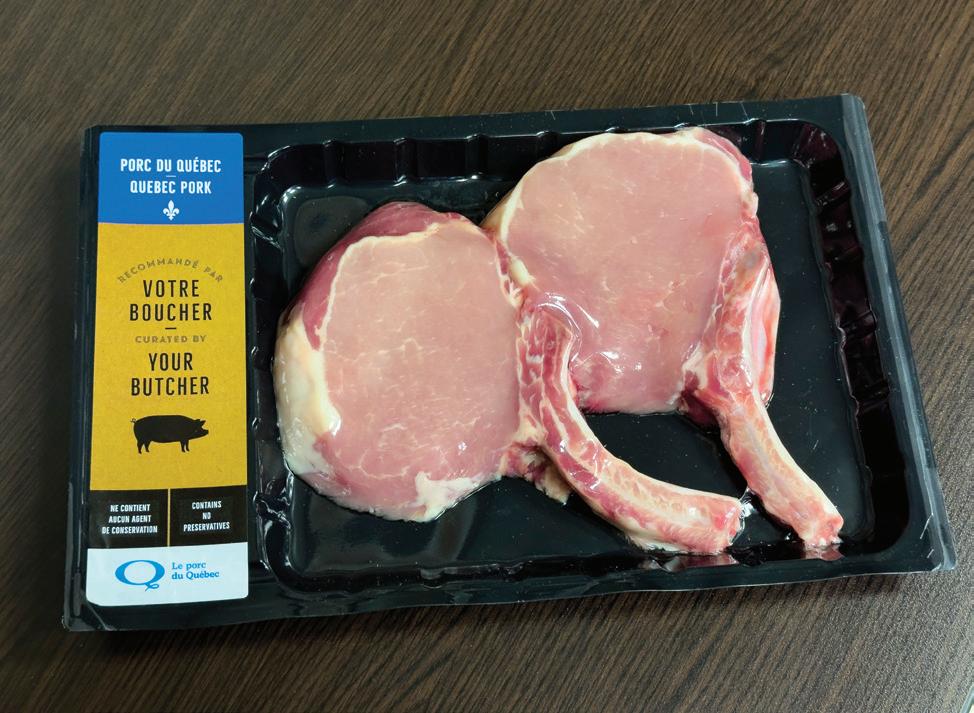

“We want to progressively expand our offering to produce case-ready products regionally and nationally,” Koukos says. “Part of our business model is to always think ahead strategically.
“Our key objective is to invest heavily into our retail brand,” Koukos sums up. “This is the one Alpha focus which is very important to us. We have set some exciting goals and a course of action, and we are ready to execute.”
SUPPLIERS
MULTIVAC Canada
May 2024 · CANADIANPACKAGING 21 CANADIANPACKAGING.COM
Right
Both MULTIVAC machines incorporate on-board labeling systems for fully-automatic label placement.
Please see a video of the MULTIVAC vacuum and skin packaging machinery in action at the Alpha Meat Packers plant in Montreal on Canadian Packaging TV at www.canadianpackaging.com
* Sanitizers
* Entry Control
* Hygiene Stations
* Handwash Stations
* Sole & Boot Cleaning
* Knife Cleaners
* Mesh Glove Cleaners
* Locker Room Storage
* CSA/ESA Approved
* Demo Facilities
* Full Layout Design

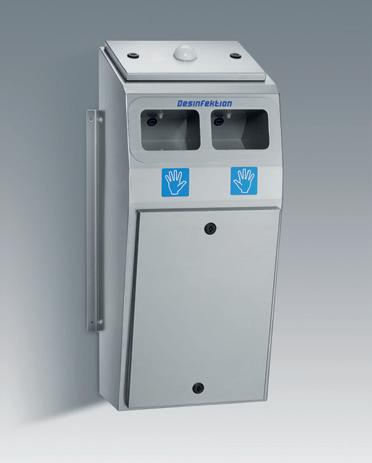


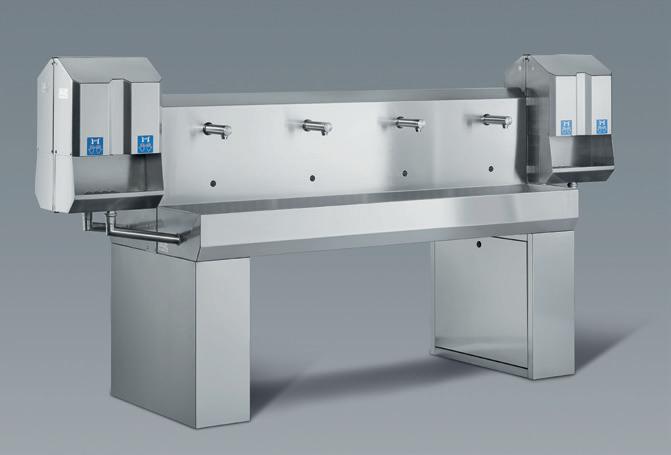


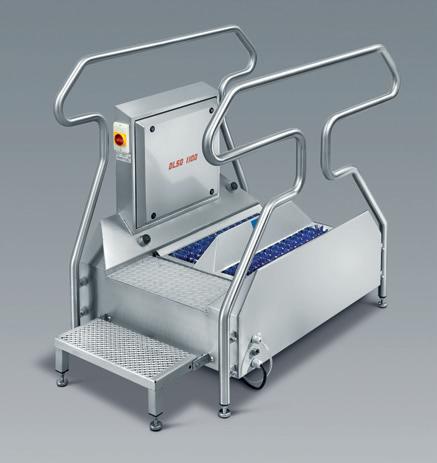
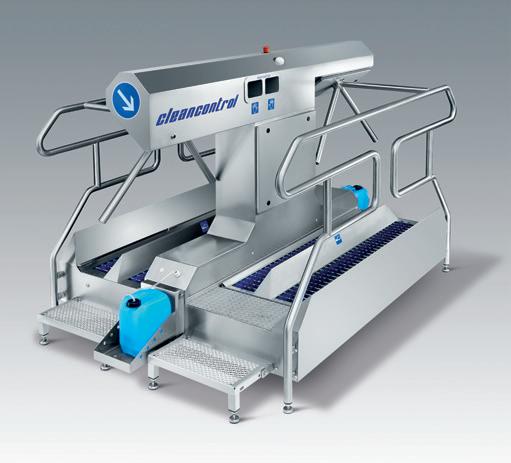





HYGIENE EQUIPMENT SOLUTIONS Handwashing Sole & Boot Knife & Glove Cleaning www.shawpak.com FOOD SAFETY REVOLVES AROUND SHAWPAK YOUR TRUSTED ADVISOR Hygiene Station Oakville 905.847.0122 Hygiene Equipment . Product Inspection . Packaging Equipment Consulting Services . Training & Demonstration Facility Essential tools to minimize the risk of pathogen transmission / cross-contact in production areas. Ensures employee health and personal hygiene compliance
largest
standardized
For more information info@Shawpak.com WWW.SHAWPAK.COM Montreal 514.566.7093 Edmonton 780.224.0776 Hygiene
Hand
Contact Shawpak to find out why some of the
Food manufacturers have
on Shawpak Hygiene Solutions across North America
Equipment
Sanitizers
Chapman’s chief operating officer Ashley Chapman flashes a welcoming smile at the company’s boardroom in Markdale, Ont., where the family-owned business celebrated it 50th anniversary last year.
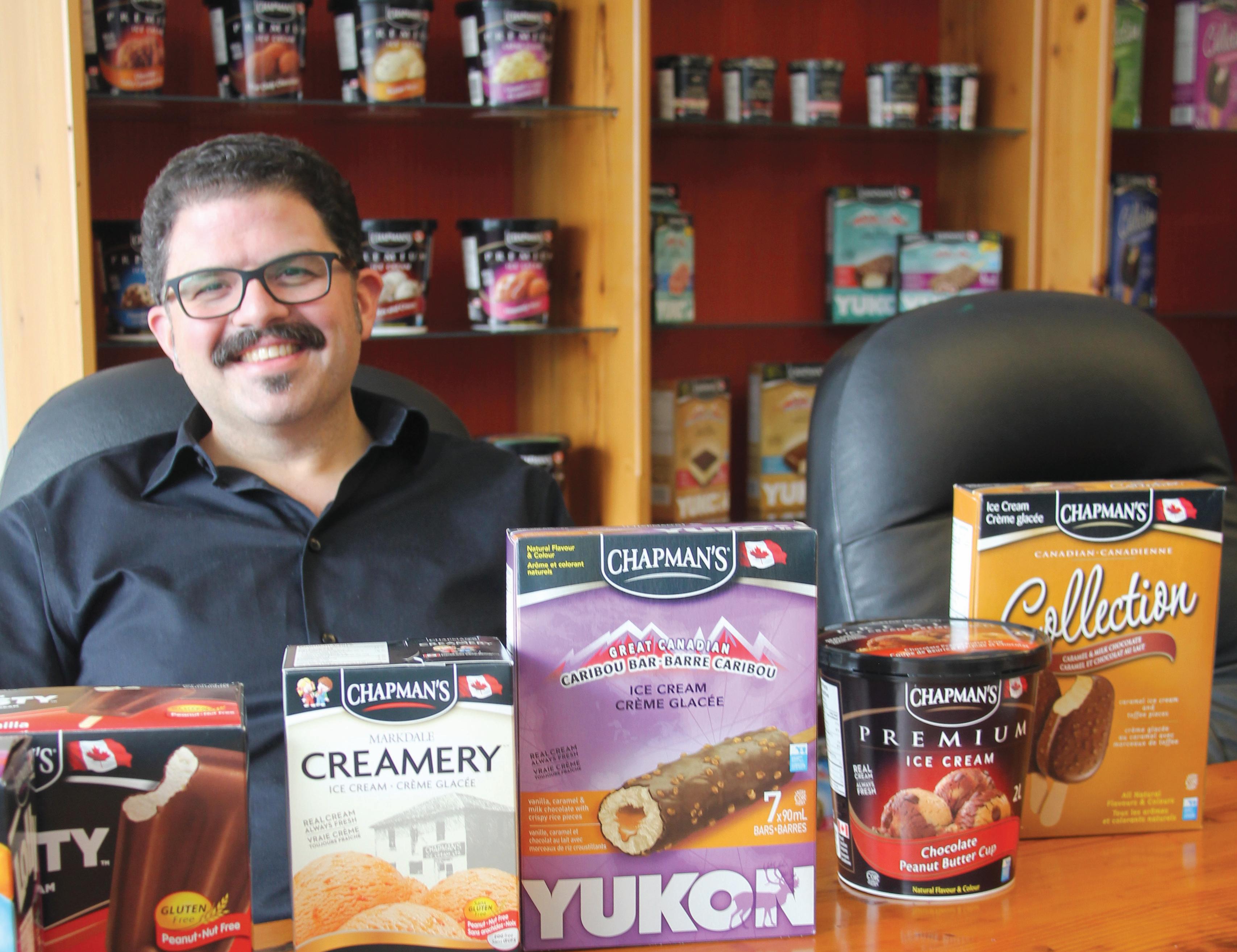
STICKING AROUND
Canadian ice-cream stalwart leverages product innovation and packaging excellence to solidify its industry leadership credentials.
By Andrew Snook
If there’s any one company that has been synonymous with ice cream and other frozen treats beloved by Canadians across multiple generations, it’s Chapman’s
Originally established in 1973 by David and Penny Chapman, the Markdale, Ont.-based producer has grown to become the country’s largest family-owned, independent ice cream manufacturer.
Nowadays operating under the leadership of the founders’ son, Ashley Chapman, the company produces more than 280 frozen treats ranging from premium ice creams to frozen yogurt, sorbet, water ice Lolly treats, and a wide variety of single-serve novelties.
Always striving to be at the forefront of innovation, Chapman’s has been recognized by several health organizations and
has been the recipient of numerous national and international awards.
Celebrating its 50th anniversary last year, the company continues to be an acknowledged trail-blazer in the world of ice cream, shaking up the market last year with rebranded Markdale Creamery ice cream range— packaged in signature two-liter boxes— and also moving into the luxury segment of the market with the new Super Premium Plus allergy-friendly product offerings packaged in 500-ml round tubs.
But product innovation is only a part of the Chapman’s story: so is the continuous process improvement.
One of the company’s more recent projects involved automating its largest packaging line for their popular water ice Lolly brand treats that have been keeping kids cool on hot days for many
May 2024 · CANADIANPACKAGING 23 CANADIANPACKAGING.COM
ICE CREAM PACKAGING

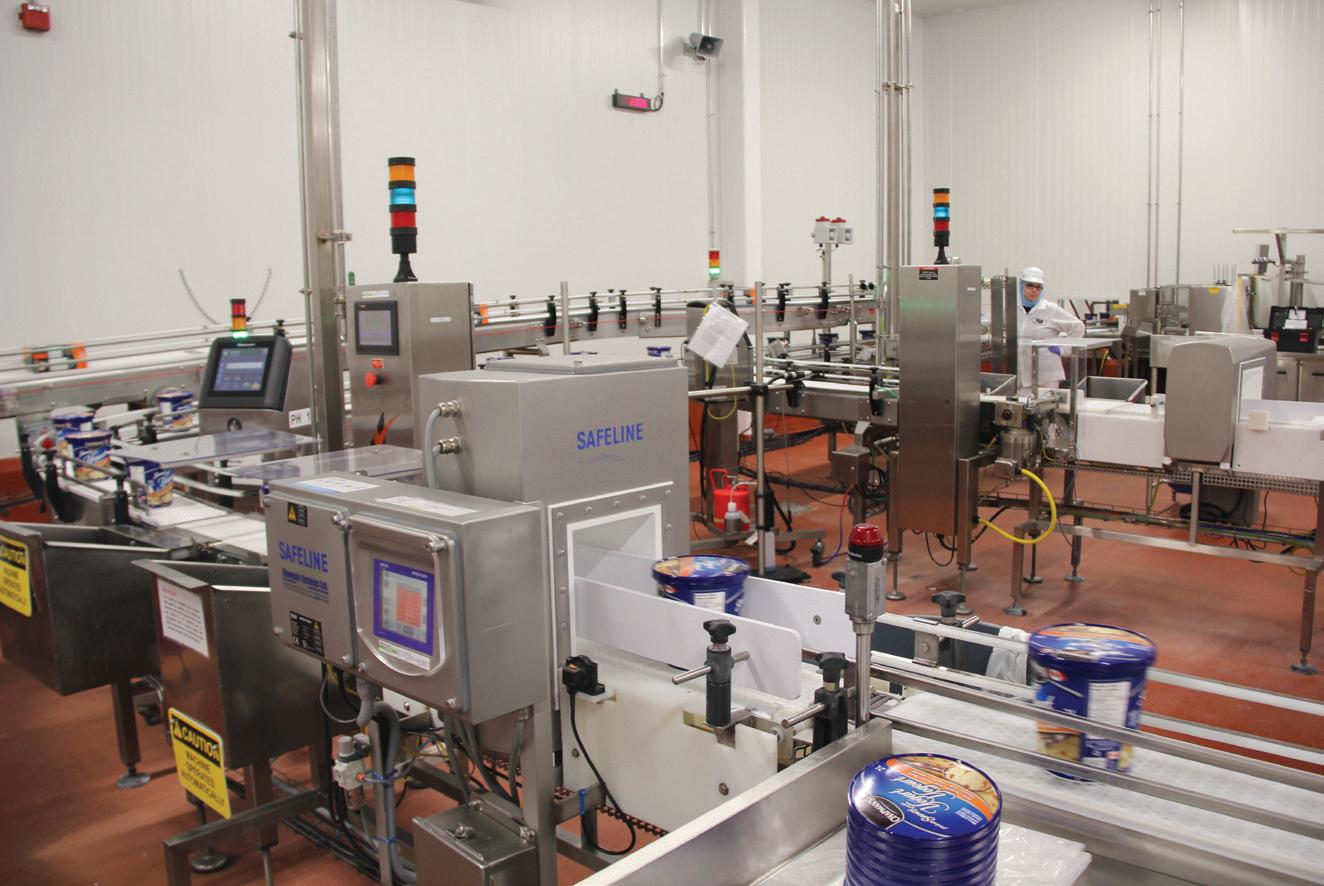
A METTLER TOLEDO Safeline metal detector and and Hi-Speed checkweigher combination installed at the Markdale plant by Shawpak Systems.
years.
According to chief operating officer Ashley Chapman, the company sells approximately four million Lolly ice treats per year.
To automate the line, Chapman’s reached out to Gram Equipment, experts in ice cream and other frozen treats production equipment based in Denmark.
Gram Equipment supplied the Chapman’s plant with a custom-built packaging line complete with a robot that gently picks up the pre-packaged Lolly bars, indexes them .and places them into the bright 28-piece cardboard packages that retailed at the grocery store freezer aisles across the country.
This process is still performed manually on a smaller production line at the plant nearby, but Chapman notes that the automated Gram Equipment line offers significant advantages.
Filled and sealed two-liter ice cream tubs, supplied to the Chapman’s plant by Stanpac, pass through the METTLER TOLEDO combination metal detectorcheckweigher station for a final quality assurance test before heading towards the secondary packaging area.
“The machine runs about 30 per cent more output than the smaller manual line with the same amount of people on the line,” he says, “except for the packing station.”
Not only does the line’s robot reduce labor requirements for packing the Lolly treats, Chapman notes, but it does it faster and more reliably.
“We have two people on the line right now, because we just commissioned it,” he relates, “but we’re going to take one of these people off in the very near future.” Chapman says investing in automation for these types of jobs is highly beneficial for the company and its employees.
“It’s all about the jobs that people aren’t really suited for anymore,” he ex-

24 CANADIANPACKAGING · May 2024 CANADIANPACKAGING.COM ICE CREAM PACKAGING
Markdale plant employees using the high-end sanitation and hygienic stations installed at the Markdale production facility by Shawpak Systems.

“If we can switch robots into that stream to do a better, faster and cleaner job, then everybody wins.”
plains. “It addresses ergonomic problems, carpal tunnel, and all those wrist issues that people get from repetitive motions.
“Humans will always be the ones that are directing the filling of the tanks, the filling of the machines—all of these things where I don’t see machines ever performing like a human,” Chapman points out.
“But for this type of stuff, if we can switch robots into that stream to do a better, faster, cleaner job, then everybody wins both the company and the employees,” Chapman states. “Especially when we’ve been having historic labor [availability] issues.”
Ashely stresses that as the company continues to automate certain aspects of production, it is not reducing its labor force.
“We’re not putting robots or automation in and firing people,” he sates. “That’s not something that we would do, regardless, but it’s also not something that the current labor market would allow.
“We just divert them to a different line,
so instead of packing products, they’re putting containers into a machine or putting chocolate chunks into a fruit feeder to get into the ice cream,” Chapman relates.
“It’s the same type of work, just a little bit more interesting.”
While the Gram Equipment line was only installed a short while ago, Ashley is very impressed with the results to date.
“It has been amazing, and commissioning was not a problem,” he recalls.
One of Ashley’s favorite features about the packaging line is that the robot’s maintenance and repair is fairly simple and straightforward.
“The beautiful thing about their system is that if I was to ever have a problem with my robot, I can pull it out, and my people can get in and pack directly in the pocket,” he says.
“It will slow down the line, but I don’t have to stop production if there was a serious issue with the robot,” Chapman explains.
“And there’s nothing to the robot: you open up the control interface and there’s

One of many SEW-Eurodrive motors deployed throughout the Markdale facility to regulate conveyor speeds.
just a couple of servos and a few wires in there,” he reveals.
“These kinds of robots have been used in automotive manufacturing and all sorts of different things for decades.”
According to Chapman, the key to keeping the line moving smoothly is the programming.
“With programming food production machines, it is pretty basic,” he says. “If you have good programming, you’re not going to have any issues.
“That’s what Gram Equipment is doing:
May 2024 · CANADIANPACKAGING 25 CANADIANPACKAGING.COM
A high-speed Videojet product coding system used to apply lot numbers and all other pertinent variable product information onto the ice-cream tubs.
hiring more programmers, and better programmers with better pay,” he states.
“At the end of the day, they know that if they can get the mechanical simple and the programming done perfectly, then the amount of service calls that they have to deal with will be next to none.”
Getting the programming right is also critical for the entire plant’s operations, Chapman points out, as all the key production equipment at the facility uses the Allen-Bradley range of controls, drives and other industrial automation devices manufactured by the leading global industrial automation powerhouse Rockwell Automation
“We are strictly Allen-Bradley,” Chapman says. “Our maintenance guys know Allen-Bradley; our engineers know Allen-Bradley.
“They are the most user-friendly [controls] for us.”
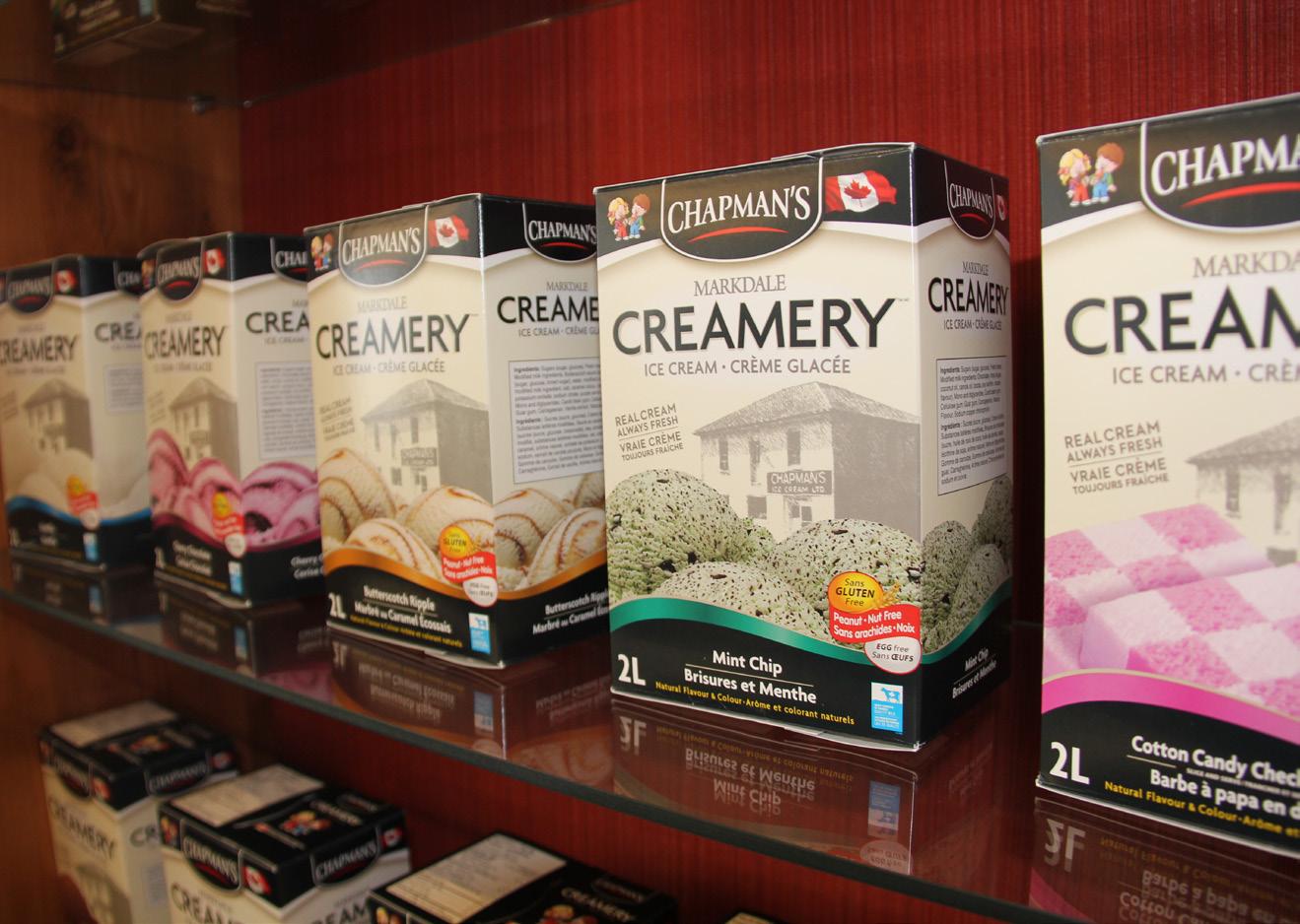
The signature two-liter ice cream boxes used for the Markdale Creamery brand are produced at Beneco Packaging’s new state-of-the art folding-carton manufacturing facility in Cobourg, Ont.
“If they can get the mechanical simple and the programming done perfectly, then the amount of service calls that they have to deal with will be next to none.”

The filled signature two-liter ice cream cartons, manufactured for Chapman’s by Beneco Packaging, riding the product transfer conveyor from the WCB Ice Cream filler towards the secondary packaging part of the production line.
Once the Lolly brand products are packaged, they go through the METTLER TOLEDO Safeline X-Ray inspection system and the Hi-Speed checkweigher scales for a final thorough quality check, before traveling towards the labeling station equipped with a Videojet 1860 continuous inkjet coder manufactured by Videojet Technologies of Wood Dale, Ill.
“Videojet are great: we’ve been doing businesses with them forever,” Chapman extols.
“Their stuff is simple, and their service agreements are awesome.”
The coded retail boxes are then sent to the end-of-packaging line to be manually placed inside the corrugated shipping cases.
With four million ice Lollys heading out the production doors every year, the company needs a regular supply of wooden sticks.
Because these day such sticks must be made from sustainably-sourced wood, Ashley says that securing a reliable uninterrupted supply is becoming trickier, with suppliers beginning to feel the impact of climate change.
“Climate change is changing the growth patterns of beech and birch trees to the point where they’re having to move to other locations to source their
26 CANADIANPACKAGING · May 2024 CANADIANPACKAGING.COM
ICE CREAM PACKAGING

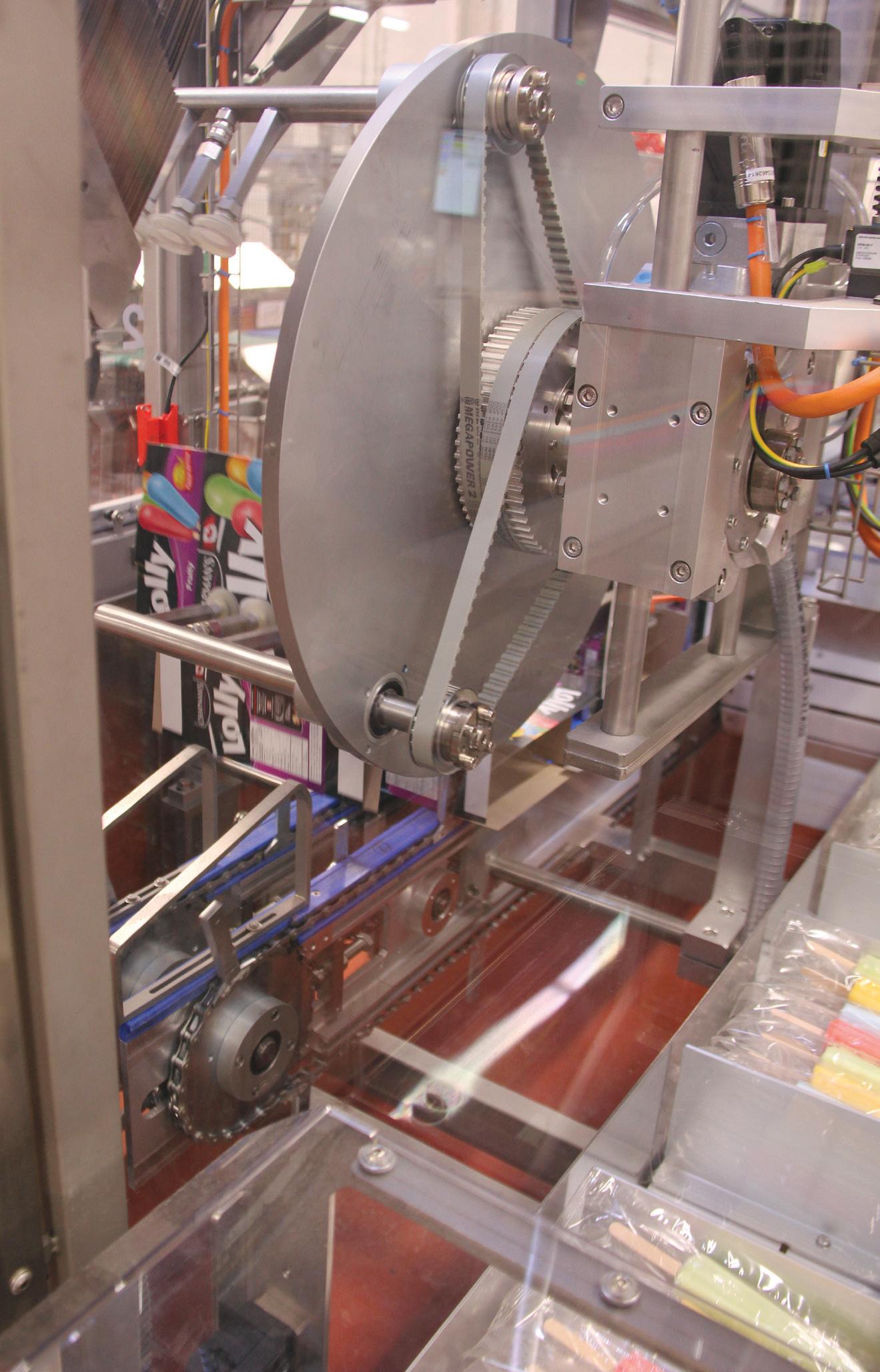

wood,” he explains.
As Chapman points out, keeping the Markdale production plant running smoothly at all times is very much dependent on finding and keeping reliable suppliers for the facility’s packaging operations.
A close-up of the boxforming system in action as it turns carboard blanks into the finished erected boxes ready to be filled with the Lolly brand ice-treats in different 28-pack product varieties.
To that end, the ice cream producer has recently formed a solid business relationship with fast-growing, Toronto-headquartered folding-carton manufacturer Beneco Packaging , which now supplies approximately 60 per cent of the folding cartons used by Chapman’s, including those used for the Lolly brand products.
“They (Beneco) do an excellent job,” Chapman states. “They have quality issues like everybody does, but they listen to us.
“We compile the data, and we hand it off to them,” he continues. “They give us a corrective action and they stick to their guns.
“And if they don’t do what’s been promised, they come back to the table and figure out a different way.
“So, they’re a great company to deal with,” he says.
Another company that Chapman’s has built a solid relationship with is Technical Adhesives of Mississauga, Ont.
“They’re the only company in the last four years that has actually given us a slight price reduction,” Ashley relates.
One package format for which Chapman’s is having difficulty sourcing a sustainable alternative is for the single-serve sundaes, which are currently packed in Styrofoam cups.
“Styrofoam is being banned soon,” he notes, “but these are used primarily for foodservice, like hospitals and long-term care and nursing homes,” he says.
As Chapman explains, the company is actively looking for an effective replacement, but hasn’t been able to find one with the same thermal properties offered by Styrofoam
The Chapman’s plant makes extensive use of food-grade hot-melt adhesives supplied by Technical Adhesives of Mississauga, Ont., for its carton erecting and closing applications.
“You can take these sundaes out of the freezer and they can travel 30 minutes on a tray, get to the end-line consumer, and it’s still solid ice cream,” he explains.
“You take a paper cup and that melts down in about 10 to 11 minutes,” he says.
“And for hospitals and long-term care homes, it’s really difficult for them to get it to their patients,” he relates.
“So, we’re trying to figure out something sustainable.”
While Chapman’s was able to find one possible alternative, he relates, it proved to be extremely cost-prohibitive.
“We have tried one option, but unfortunately the cost was about 10 times that of Styrofoam,” he confides.
“We did a trial on it and that raised the time to 16 or 17 minutes, which is re-
28 CANADIANPACKAGING · May 2024 CANADIANPACKAGING.COM ICE CREAM PACKAGING

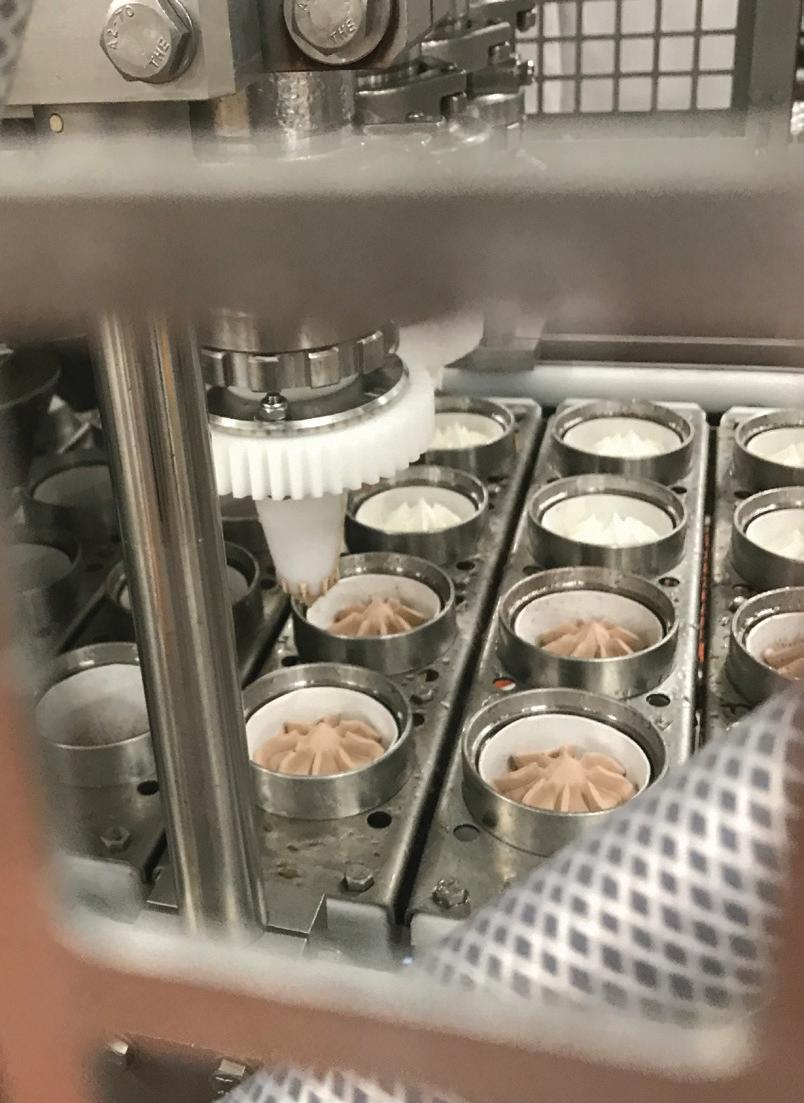
spectable, but the cost of doing it was just exorbitant.”
With 280 different product offerings, going out into the market, Chapman’s uses a wide variety of different package sizes and shapes.
That said, the company does try to simplify packaging operations whenever possible and practical, as illustrated by 28-packs of ice Lolly treats.
“That 28-pack is all we run now,” Chapman says. “We run the fruit products in there, our triple-treat products, banana, chocolate, all in the same box— same shape, different mix.”
“That (Gram) machine runs 48, 49 weeks out of the year, and it just keeps on going.
Says Chapman: “As soon as you get to a situation on a machine where you’ve got to switch between different formats, it can be a nightmare.”
While the quality of packaging performance is naturally a top priority for Chapman’s, sustainability is also important.
For Chapman’s, taking a holistic approach to sustainability that encompasses all aspects of the operations is the right path to follow.
“It’s a big deal for us,” Chapman states. “We’ve really improved our systems over the years to make sure that if we need 10,000 packages, we don’t run 15,000 packages to get those 10,000 packs.
“But we also look at sustainability more in a holistic sense,” Chapman expands. “So it’s not just the machines, it’s not just the packaging: it’s the whole process.
“Even all of our wastage ice cream goes to the local pig farms.”
As Chapman emphasizes, , the company is always trying to position itself as a leader when it comes to staying on top of sustainability regulations.
“We’ve always done more than was required by the government,” Chapman states.
“Our conversions to paperboard from plastic was a big deal in 2011, as it did a lot of good for the environment.”
However, Chapman says the company is starting to hit a wall when it comes to finding more ways to be sustainable, and that the packaging industry needs to find ways step up their innovation in this regard.
“The packaging industry is falling behind in some of the most important areas, which are single-use plastics,” he comments.
“We need a compostable and recyclable wrap, so it doesn’t matter where you are—northern Ontario or the GTA (Greater Toronto Area) region—people can put it into a waste-stream that can deal with in a responsible manner.
“There are certain types of packaging right now that are technically recyclable,” he acknowledges, “but there are only a few places in the entire country that can properly break those things down.
“We need more oversight from the federal government, and more guidelines on what people should be using,” Chapman states.
To address the issue, Chapman suggests that Canada should follow in the
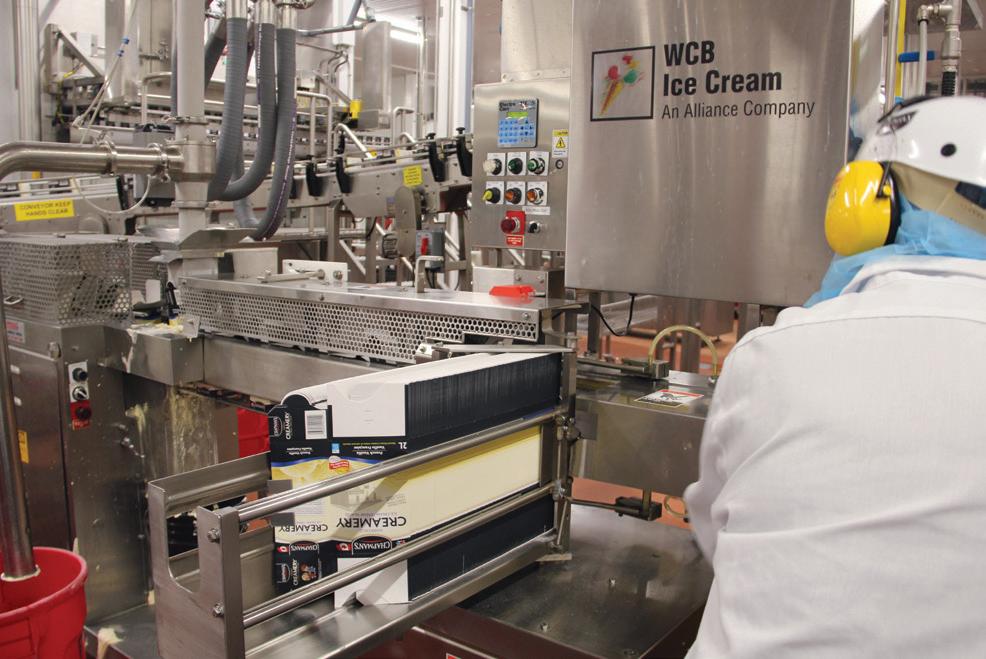
Markdale plant machine operator making sure there is always an uninterrupted flow of the two-liter ice cream cartons being fed inside the WCB Ice Cream filler during production runs of the company’s flagship Markdale Creamery ice cream products.
footsteps of other countries, like Italy, which are making real progress in moving towards a Circular Economy model for food production.
“Look at a place like Italy,” he states. “Italy has an entire infrastructure built around one set of standards for composting.
“They’ve been doing it for around 150 years and now they’re starting to have a ‘good’ problem of having too much soil,” he points out. “That’s the direction in which we should be moving as well.”
SUPPLIERS
Beneco Packaging
Technical Adhesives
Shawpak Systems
Gram Equipment
Videojet Technologies
Rockwell Automation
Stanpac
May 2024 · CANADIANPACKAGING 29 CANADIANPACKAGING.COM
A
Production line workers making sure the Lolly ice treats are conveyed inside the Gram Equipment packaging system in proper order and orientation.
Paperboard tubs supplied by Stanpac being filled with ice cream product.
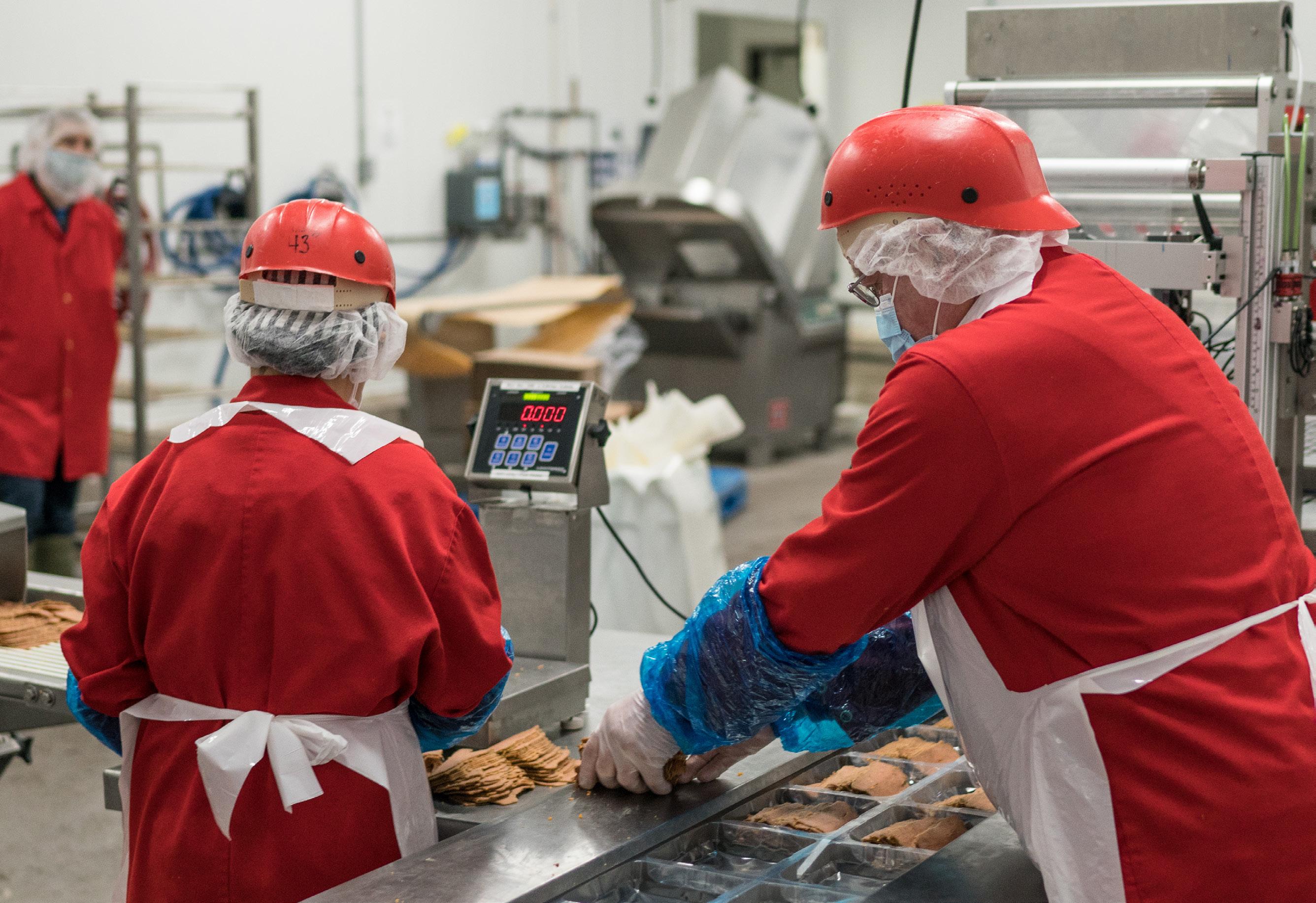
CUTS AND GLORY
Canadian meat industry emerges from post-pandemic uncertainty to begin recapturing lost ground in the global export markets
As one of the world’s largest producers and exporters of beef, pork and other red meat products, the Canadian meat sector is one of the country’s most important generators of revenues, employment and trade— contributing well over $24 billion to the nation’s GDP (Gross Domestic Product) each year.
And while the industry has endured a lot of pain and uncertainty during the prolonged COVID-19 global epidemic and the resulting supply chain disruptions, the sector’s long-nurtured resiliency and grace under pressure have enabled it to bounce back from those dark days relatively quickly—to the collective benefit of Canadian consumers and the country’s meat product manufacturers and their suppliers.
With the Canadian Meat Council (CMC) preparing to highlight and
celebrate the Canadian meat industry’s accomplishments at the group’s upcoming 2024 Conference and Annual General Meeting next month in Ottawa, June 10, 2024, the Canadian Packaging magazine recently reached out to CMC chair Kerry Towle, vice-president of industry and government relations at Sofina Foods Canada , and vice-chair Russ Mallard, president of P.E.I.-based Atlantic Beef Products, to discuss the challenges and opportunities facing the nation’s top meat producers in coming years.
QPlease provide a macroeconomic snapshot of the state of the Canadian meat processing industry at the moment.
Canada’s meat industry is a big part of the country’s economy and generates significant revenue and employment each year.
In 2022, the meat processing industry shipped products worth $24.72 billion, showcasing its substantial economic
30 CANADIANPACKAGING · May 2024 CANADIANPACKAGING.COM
MEAT SECTOR OUTLOOK 2024
impact and contribution to Canada’s overall economy. The red meat processing industry—comprising beef, veal, pork, lamb and horse-meat—is the largest sector of the food manufacturing industry in Canada, with annual revenues valued at over $16.3 billion and total employment of over 64,000 people.
In 2022, the volume of beef produced in Canada amounted to 1.38 million metric tons. Canada’s meat processing companies manufacture a wide variety of meat products ranging from fresh and frozen meat to processed, smoked, canned, cooked, and sausage and deli meats.
Canada is a significant exporter of meat products—exporting over half of total production. The Canadian meat industry is domestically and globally recognized for well-established safety standards of the highest quality, as overseen by the Canadian Food Inspection Agency (CFIA).
Led by pork and beef, meat is one of Canada’s highest valued agri-food exports. The meat industry is the largest part of Canada’s food processing sector with annual sales surpassing $31 billion in 2023, and red meat exports valued at $9.7 billion in 2023.
Canada’s consumption of red meat was estimated at $13.4 billion in 2018 and 13.9 billion in 2019.
The number of direct jobs in the Canadian red meat sector in 2021 was 40,131, accounting for the workers employed in employment of production workers for animal slaughtering (poultry excepted), and for carcass rendering and meat processing.
In 2021, the total number of people employed within the Canadian red meat sector was 48,156, representing seven-percent growth in the total number of direct and indirect jobs in 2020.
QWhere does Canada’s meat industry rank on the world stage in the context of global economy?
The sector takes pride in feeding families in Canada and around the world.
Canada stands out as the fifth-largest exporter of agricultural and agri-food products globally. The meat processing industry is the largest component of Canada’s food processing sector, accounting for about 12 per cent of the country’s agri-food exports and employing over 64,000 Canadians.
In 2022, Canadian farmers and food processors exported $9.5 billion dollars in red meat products, which includes pork, beef, lamb,and horse.
As the global per capita consumption of meat is expected to rise in the next 10 years, Canada’s opportunity to export red meat products will continue to grow.
On average, 50 per cent of Canada’s


beef production and 70 per cent of its pork production is exported, excluding live animals sent to the U.S. for feeding and slaughter.
All in all, Canada is a highly efficient producer of high-quality beef and pork products—exporting to over 90 countries worldwide.
For its part, the overall trend for meat consumption in Canada appears to be relatively stable. According to the OECD data, Canada’s projected per capita consumption of beef and veal, pork, and sheep meat in 2029 will be relatively flat compared to current levels.
Founded more than a century ago, Canadian Meat Council represents Canada’s federally licensed meat packers, meat processors and suppliers of goods and services to the meat industry.
This research indicates a growing trend among younger Canadians, particularly Millennials and Gen Z, to consume less meat and shift towards other alternatives.
According to Statistics Canada , total beef consumption in Canada declined by 6.6 per cent in 2021 to 919,720 tonnes, even as domestic production rose by 4.3 per cent.
The decline in beef consumption was predominantly due to strong global meat demand for Canadian beef exports and for fewer beef imports—resulting in less beef available for the domestic market.
In addition, supply chain pressures and food inflation resulted in higher beef prices and declining consumer purchases. As a result, per capita beef consumption in Canada fell by 7.2 per cent in 2021 to 16.9-kg retail weight.
Despite its relatively small population, Canada exports almost 50 percent of its total beef and cattle production. In 2022, beef exports were valued at $4.7 billion, doubling in the past 5 years reaching 511,000 tonnes, the second largest year for export volume on record.
Work in international markets continues to create opportunities for the Canadian beef industry to realize greater value for the carcass than could be realized in the domestic market alone.
About 95 percent of Canada’s cattle
and hogs are processed in federally inspected facilities, ensuring high standards of quality and safety.
QPlease describe the impact of the post-COVID inflation in terms of the cost of production inputs and the retail-level cost to consumers.
Meat price inflation can be traced directly to the energy prices, which surged in early 2022 due partly to the Russian invasion of Ukraine and reduced oil output from oil-producing nations. In August 2022, meat prices in Canada were up 7.6 per cent year-over-year, lagging the overall food price inflation rate. Fresh beef prices rose by 6.7 per cent, while beef steaks were up 10.7 per cent in January of 2024 compared to a year earlier. In contrast, pork prices increased by only 0.2% year-over-year in August 2022, the slowest among fresh meats. However, processed products like lunch-meat (up 24.2 per cent), sausages (up 15 per cent) and frankfurters (11.3 per cent) experienced the fastest price growth.
But while meat prices have increased, the rate of inflation has generally been more moderate compared to other major food categories. Our industry is aware of this challenge for consumers by and striving to process our products in the most efficient manner possible.
QMany Canadian food industry sectors are concerned about the speed and scope of the federal ban(s) on single-use plastic packaging. How big of a deal is this in the meat industry, and how is the meat industry responding to it?
The use of plastic packaging is crucial for preserving the safety of meat products in the meat processing sector.
While the Canadian government is working to reduce plastic waste and promote sustainable procurement across all sectors, it recognizes the important role of plastics in meeting the high food safety standards for meat products manufactured in Canada.
The government has created a regulatory framework to achieve its plastic reduction objectives,, and the meat industry is advocating for solutions that allow industry time to adopt the technology that will serve the dual purposes of environmental sustainability and food safety.
The meat industry is closely monitoring this file and understands Canada’s ongoing engagement in an ambitious global treaty on plastics.
The industry is committed to finding ways to balance the need for food safety with the drive for more sustainable packaging options.
May 2024 · CANADIANPACKAGING 31 CANADIANPACKAGING.COM
From Left: Canadian Meat Council chair Kerry Towle, vicepresident of industry and government relations at Sofina Foods Canada, and CMC vice-chair Russ Mallard, president of Atlantic Beef Products.



QHow concerned should Canadian consumers be about deadly disease outbreaks in some animal species critical to the industry’s economic well-being?
The African Swine Fever (ASF) is a disease that only impacts pigs, it is harmless to humans but poses a significant risk to the pork industry and the Canadian economy.
Pork products are safe to eat, and consumers can enjoy them with confidence.
The pork industry, together with the Canadian government, has a comprehensive rapid response plan to contain and eradicate ASF if it occurs, including restrictions on transporting animals from affected areas, sanitization processes and careful surveillance.
Preventing its introduction through stringent import restrictions and traveler precautions is a top priority. Business continuity is important for Canada in case an ASF outbreak hits Canada, which is why Canada is actively engaged in establishing ASF zoning agreements with the U.S., EU, U.K., Hong Kong, Singapore and Vietnam—covering 34 per cent of pork exports.
QTo what extent has the meat industry been impacted by the well-publicized labor shortages affecting many other Canadian economic sectors?
The meat processing sector is facing a critical labor shortage and relies heavily on temporary foreign workers to fill positions. In 2022, the government introduced temporary measures to increase the TFW cap to 30 per cent for the meat industry to address labor shortages.
Alas, we consider the recent decision to unilaterally end these temporary measures without industry consultation as being hasty and premature.
The Canadian Meat Council is deeply concerned that the reduction in TFW access will have “significant consequences” for meat processors and their
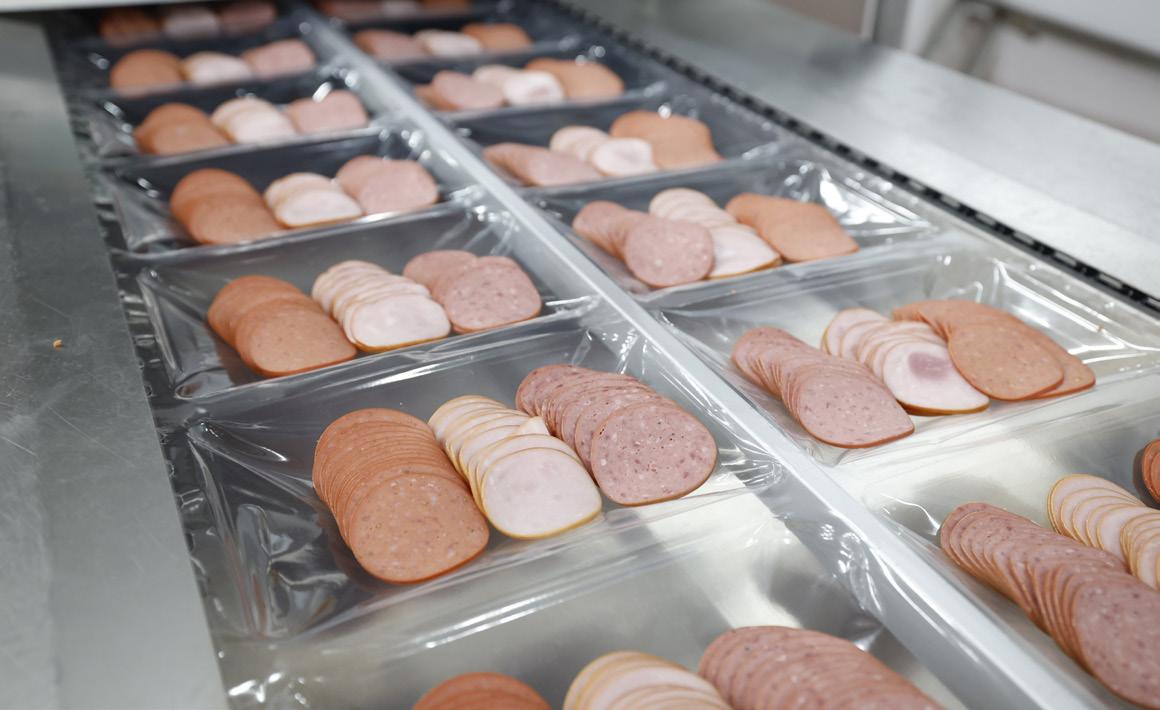
ability to supply products to consumers at affordable prices, while exacerbating labor shortages and adversely impacting food affordability and supply.
QPlease describe the current state of global trade in meat products and its impact on Canada.
Trade has become a major driver of growth for the Canadian meat sector over the past few decades. This export orientation has been crucial for supporting profitability and expansion in the Canadian meat industry, as producers are able to sell each cut and byproduct to the highest bidder globally.
With global per capita meat consumption expected to rise in the next 10 years, Canada’s opportunity to export red meat products will continue to grow.
Overall, trade has become deeply integrated into the business models and growth strategies of the Canadian meat companies and producers, enabling an economically and environmentally sustainable sector.
Although, tariffs are still a major impediment for expanded access to South Korea, the Canada-Korea Free Trade Agreement (CKFTA) is the first FTA that Canada concluded and implemented with a trading partner in Asia.
Prior to the implementation of the CKFTA in 2015, Canada’s meat exports to South Korea had plummeted by over 50 per cent, as the country signed trade deals with competitors like the U.S. and EU, putting Canadian producers at a major tariff disadvantage.
The CKFTA has been instrumental in restoring Canada’s competitiveness and market access in South Korea. Since it went into effect, Canada’s beef and pork exports to South Korea have surged, with a compound annual growth rate of nearly 60 per cent for beef and over five per cent for pork between 2018 and 2022. South Korea is now Canada’s fifth-largest market for meat exports, accounting for over $300 million in sales annually. Maintaining competitive access to this lucrative market is essential
for the profitability and expansion of the Canadian meat industry.
QWhat has been the impact of the COVID-19 epidemic on the Canadian meat sector?
Like many other industries, the red meat sector is still struggling with an adequate supply of labor post-COVID, due to a shrinking Canadian workforce demographic and the redistribution of labour availability following the pandemic.
According to Food Processing Skills Canada (FPSC), a single unfilled position costs food and beverage manufacturers as much as $190 per day in lost net revenue. With an average of six vacant positions per food and beverage processor, industry-wide losses are a staggering $8.5 million per day, which translates into $3.1 billion a year.
Between current vacancies and replacements due to death or retiring, the food and beverage industry will need to hire 50 per cent of today’s workforce by 2030. Despite the meat processing sector being the largest segment of food and beverage manufacturing, some CMC member-companies are reporting vacancy rates as high as 20 per cent. This poses a serious risk to Canada’s red meat food supply, as manufacturers are forced to limit production or stop producing some products altogether.
Q Are there any major regulatory issues facing the industry?
The Specified Risk Material (SRM) Removal policy is a significant challenge and a contentious issue for the Canadian meat industry.
While Canada and the U.S. have both been recognized as having a “negligible risk status” for Bovine Spongiform Encephalopathy (BSE), the differing SRM policies between the two countries put Canadian abattoirs at a competitive disadvantage. Canadian abattoirs must remove an average of 57 kilograms of SRM material from each animal, whereas the U.S. only requires the removal of three kilograms for animals over 30
In 2002, Canada exported $4.8 billion worth of pork product to 77 countries, according to CMC, ranging from fresh cuts to processed luncheon meats.
May 2024 · CANADIANPACKAGING 33 CANADIANPACKAGING.COM MEAT SECTOR OUTLOOK 2024
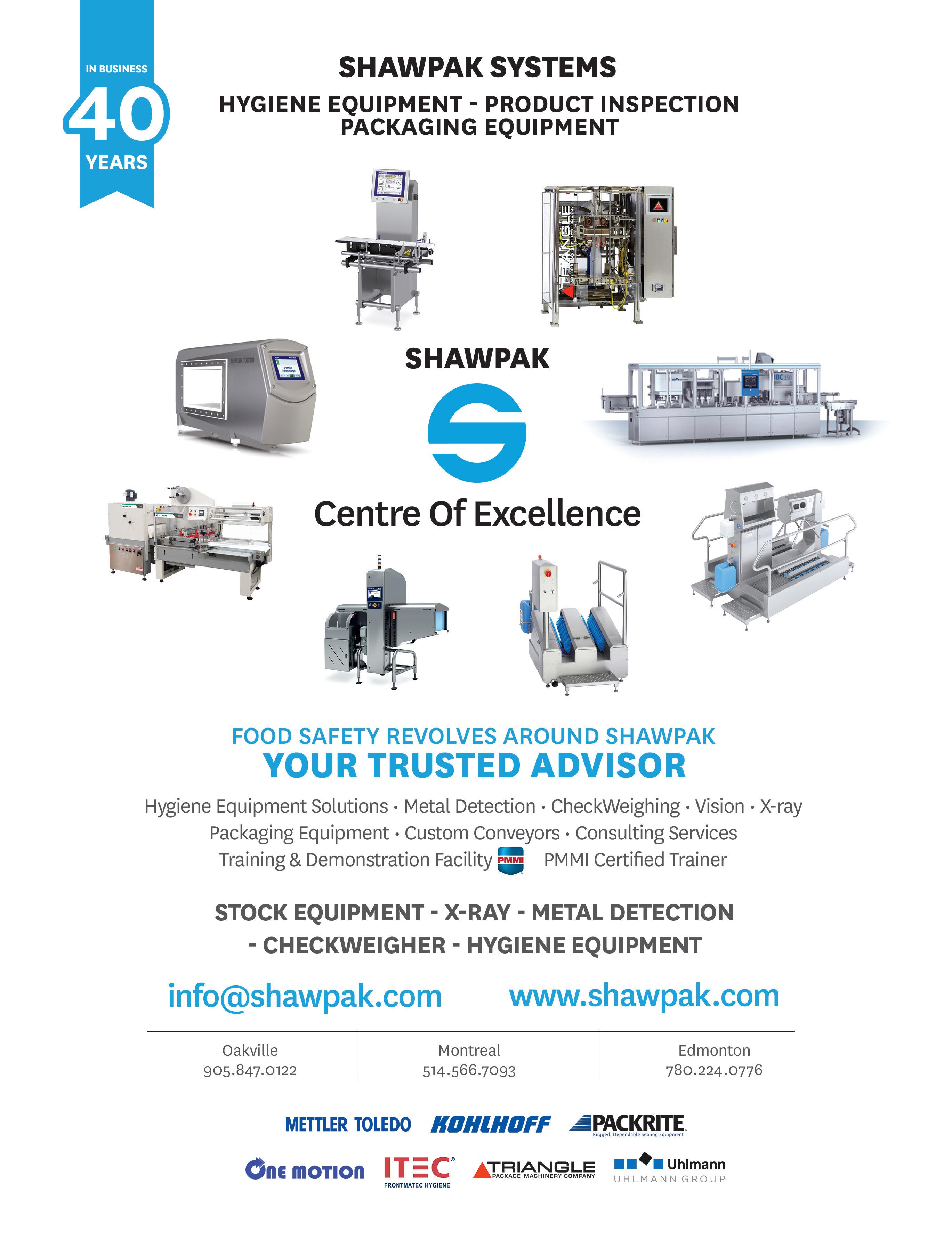

months of age. For animals under 20 months, Canada must remove 7.2 kilograms compared to three kilograms in the US. The disposal cost for this additional SRM material in Canada averages $167 per metric tonne, resulting in an annual industry cost of about $31 million. The industry is working with the government to address this issue.
QWhat are some of the most urgent market access issues impacting meat exporters today?
Despite Canada’s attainment of negligible risk status for BSE, some countries have yet to remove the trade restrictions that were implemented after the first BSE case was discovered in Canada in 2003.
The Canadian Government Market Access team—comprising representatives from Agriculture and Agri-Food Canada , Global Affairs and the CFIA—is working with international counterparts to negotiate the removal of these outstanding restrictions.
These restrictions include limits on the export of animals under 30 months of age, bone-in beef and offal, and meat and bone meal.
China remains a particularly challenging market for the Canadian meat industry, which is focused on finding a long-term solution to secure stable and reliable access to the Chinese market.
This effort involves collaboration with the Canadian Embassy in China, the Chinese Ambassador to Canada, and regular engagement by Canadian Meat Council staff to build relationships in the Chinese market. The Canadian industry is also in the process of opening a Red Meat Advocacy Office in Beijing, which will represent Canadian interests in maintaining market access to this particularly important market.
QWhat are the companies in your sector doing to lower their environmental and packaging footprint?
Many CMC member-companies have implemented up-to-date sustainability plans at their processing plants. These plans tackle key environmental impacts like water usage, energy consumption, and waste reduction on an ongoing basis. Companies are taking actions such as metering water inflows and outflows to track progress towards conservation goals. They are also retrofitting facilities to incorporate solar and thermal power sources, minimizing the overall environmental footprint.
While individual companies actively seek ways to reduce plastic usage, it is just one piece of the environmental puzzle. Food safety must remain a priority as we explore minimizing packaging.
Encouragingly, innovation and research have introduced cost-effective alternatives that some members have adopted. Looking ahead, discussions are underway to explore setting industry-wide sustainability targets through frameworks like the Protein Pact. Defining benchmarks for individual companies to measure themselves against would be beneficial for driving improvements across the entire meat industry.
QWhat should the Canadian governments be doing do to help ensure a healthy and viable Canadian meat processing industry? Consistency is critical to the viability of the meat industry. The meat industry is facing major policy shifts as people place more importance not only on where their food comes from, but also how it is made.
able for Sustainable Beef (CRSB) , the GHG emissions of Canadian beef production have a total footprint of 11.4 kg CO2 equivalent—representing 2.4 per cent of Canada’s overall emissions, less than half the world’s average.
Also, according to the CRSB,the land used for beef production and managed by Canadian farmers and ranchers helps to sequester over 1.5 billion tonnes of carbon in Canada.
Our sector continues to work with industry and government partners on reducing methane emissions from livestock through feed additives, improved manure management, and breeding for lower-emission animals. It is also increasing efficiency and productivity to produce more meat with fewer animals and less land/resources, while transitioning to renewable energy sources,
“When the government is considering new regulations or standards, it is crucial that they engage the industry at the beginning of the process.”
To navigate these complex challenges, the industry needs to be at the forefront of policy discussions with the government. Engaging early and often with policymakers is essential for the industry to have a meaningful voice in shaping the policies that will impact its future. Communication is essential for our highly regulated sector. When the government is considering new regulations or standards, it is crucial that they engage the industry at the beginning of the process. Involving the industry from the outset allows for meaningful dialogue, helps avoid serious problems, and ensures that the new regulations are practical, effective, and do not create unintended consequences for the supply chains.
QOften portrayed as one of the biggest sources of greenhouse-gas (GHG) emissions into the atmosphere, what must the meat industry do to lift its environmental image and profile both worldwide and in Canada?
According to the Canadian Roundt-
improving energy efficiency in processing plants, and investing in carbon capture and sequestration technologies to offset remaining emissions.
QPlease describe the overall level of automation in the meat industry.
The Canadian agriculture and meat processing industry has introduced many new technologies over the last decade: from data systems advising farmers when to spray, seed and harvest their fields to robotic milking machines and AI to create the ideal facilities to grow crickets.
The federal government has recognized the need for automation in the meat processing industry and created the Canadian Agri-food Automation and Intelligence Network with funding for a beef and pork primary processing automation and robotics program. Many meat processing facilities are introducing robotic packaging and meat-cutting technology, as the current labor challenges have provided a strong incentive for the industry to do so.
May 2024 · CANADIANPACKAGING 35 CANADIANPACKAGING.COM MEAT SECTOR OUTLOOK 2024
ACING THE TEST
Industrial machinery
certification services
provider on a global quest to make industrial safety the common denominator
Considering all the due diligence and multiple evaluations that go into making capital investment decisions for expensive industrial machinery and equipment, there’s nothing like having a credible and authoritative third-party certification to reassure companies that their investment if money well-spent.
While national certification bodies like the CSA (Canadian Standards Association) may be a good starting point, the sheer technological complexity and the pace of change in machinery design and key performance indicators often require highly specialized knowledge and expertise to confirm that the purchased equipment will perform in the field exactly as intended.
That’s where companies like AC&E come in.
Started up in Italy over 20 years ago, AC&E is a globally accredited laboratory providing a comprehensive range of export certification, lab and testing, and tech and legal services to enable its customers worldwide to keep pace with technical and regulatory development.
Having completed more than 1,000 system installation certifications around the world to date, the company operates in several key strategic global markets— including Canada—helping manufacturers large and small to achieve meaningful lasting success with their capital investments.
With the company actively boosting its presence in Canada in recent years, the Canadian Packaging magazine recently reached out to AC&E’s president and founder Gino Zampieri, as well as the company’s international technical director and co-founder Matteo Marconi, to find out more about the company’s unique strength and competencies in the third-party certification business.
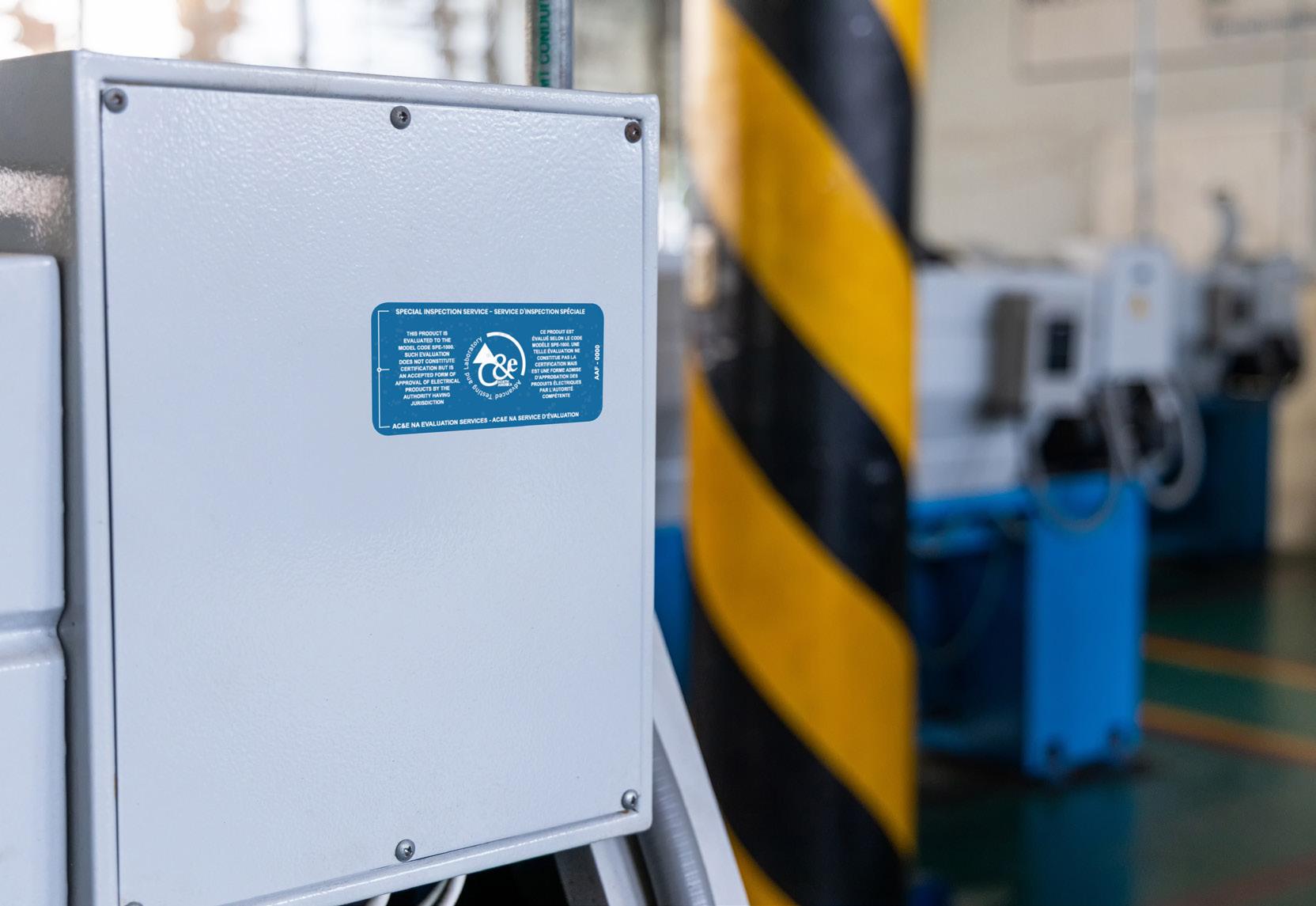
Please provide a brief history of your company and an overview of the services you offer to the industry in general and the packaging machinery sector in particular.
AC&E was founded 20 years ago by two engineers driven by the vision and passion to fill the market need for a reliable and professional partner to help Italian machinery manufacturers to break into new export markets.
Thanks to the competence and knowhow of its founders, the company seized the opportunity for sustained organic growth by offering third-party lab testing services and partnering with international accredited manufacturers like Siemens to organize regular, dedicated technical seminars providing valuable updated information on the safety and certifications worldwide.
Today, AC&E is a nationally and internationally accredited independent third-party testing, certification and field validation agency headquartered in Italy, with close proximity to its international customers in China, Brazil, Spain and North America.
The AC&E engineering team and inspectors offer collaborative support throughout a project to enable customers to meet their national and international regulatory requirements in timely and cost-effective manner.
How do the testing/accreditation/
An electrical cabinet panel bearing an AC&E certification symbol for electrical and mechanical safety for packaging and other industrial machinery is becoming a more common sight at manufacturing facilities across Canada.
consulting services you provide differ from the basic standards of national certification agencies, such as CSA in Canada?
Our main aim is to support the customers on 360-degree basis, whereby our team guarantees a complete support service starting from the very outset of a project to the final field evaluation, providing support to the client through each step of the process.
How big is the Canadian market for these services, and is there anything unique about the Canadian market compared to your other markets?
More than half of AC&E Group’s global turnover comes from North American-based projects, with Canadian market accounting for 50 per cent of that share.
The majority of our customers are Italians who export to North America, and they are well aware of the importance of being in strict compliance with local requirements in markets like Canada.
A partner company like AC&E NA (North America), which is recognized and well-known to Canadian authorities in each province, plays a critical support role for installing safe and compliant equipment.
Our relationship with the Canadian authorities is always direct and functional, allowing AC&E to conduct smooth and comprehensive field evaluations.
36 CANADIANPACKAGING · May 2024 CANADIANPACKAGING.COM QUALITY CONTROL
How does the company select the global markets where it does business?
We go where our customers require us to go, which is why we have established several subsidiaries in China, Spain and Brazil to support specific requests and needs of our existing customers.

How many inspections and certifications does you company typically carry out in Canada and worldwide annually?
Last year AC&E NA carried out 206 inspections in North America, 50 per cent of them in the Canadian market.
AC&E provides direct support related to safety engineering. We work closely with machinery designers and manufacturers to make sure that all the sizing and . safety checks are up to the international standards.



It is worth noting that we have suspended all communications related to our Russian-based subsidiary, putting that relationship on hold for the time being.
What types of machinery does your company typically inspect, evaluate and certify?
AC&E specialized in the compliance of every type of electrical industrial equipment. The majority of the machines we inspect are intended for use in the pharmaceutical, packaging, oil-and-gas, aerospace, food, logistics, machine tooling and other industrial fields.
We always inspect the compliance of the equipment from all points of view, both electrical and safety, cooperating with the customer from the very beginning and, whenever possible, before the manufacturing of the machine itself.
Most of our Italian customers produce machines for the packaging sector, as Italy is one of the world’s leading countries in terms of packaging machinery exports.
“The certified machines are thoroughly checked from every angle to ensure their reliability.”
This is one of the main reasons why AC&E has focused on developing deep expertise in the packaging field right from our early days, covering all the aspects related to electrical safety and mechanical reliability.
Please describe your standard testing and validation process for packaging machinery.
As part of that process, we provide answers and recommendations to any technical and regulatory requirements to finalize a machine that is in compliance with the Canadian standards for example.
As a result, the machines certified by AC&E are thoroughly checked from every angle to ensure their reliability and readiness to be used once installed— without any delays or any additional cost overruns.
The AC&E team is comprised of highly experienced electrical and mechanical engineers, along with technical personnel from a new AC&E division specializing IIoT (Industrial Internet of Things) and cybersecurity for safety related to data exchange between the machine, the supplier, and company’s MES (Manufacturing Execution System) software.
The whole process is developed by AC&E team, closely cooperating with





AC&E NA is a Field Evaluation Body A close-up of the AC&E certificate of accreditation for the electrical and mechanical safety of the inspected equipment. Certification for Global Markets Laboratory and testing Industrial Cyber Security We enable industrial machinery and equipment manufacturers to meet their national and international regulatory requirements in a timely and cost effective manner. Italy North America Brazil Spain China Our offices around the world: Our services for the machinery manufacturing industry: info@ac-e.com acenorthamerica.com FEB-112 06036


our customers at each single step until the final installation and verification is completed.
What are the key technologies deployed in carrying out your services, and what are the typical qualifications and experience of your company’s personnel?
Our processes are completely computerized, as AC&E is well-equipped with all the required remote inspection systems with smart glass technology for managing the quality and safety of the inspection process through a digital interface and a dedicated server—thereby guarantees full reliability of the transmitted data .
The traceability and transparency of our processes are fully guaranteed by multiple detailed pictures and visual recordings of the whole inspection process.
Our engineers are well-equipped with leading-edge measuring instruments to perform electrical safety tests, as well as temperature and functional tests also in field , as required by the CSA standards, and all our instruments are calibrated as per our ISO17025 standard certification.
Moreover, all our inspectors are continually tested and updated in their procedures and training by our senior technical team with 20 years of experience in North American markets.
In addition, they are also regularly audited and evaluated by the Standards Council of Canada (SCC) to ensure compliance to the ISO 17020 standard conformity.
What is the typical size of a company utilizing your services?
Our services range across countries and sectors, as we collaborate with customers in the packaging, pharmaceutical, aerospace, mechanical and many other industries.
Our services can be applied to virtu-
ally any kind of industrial machinery and equipment with an electrical panel or cabinet—from stand-alone machines to fully integrated production lines.
Even an SME (small and medium enterprise) manufacturer with one machine model can significantly benefit from the wide scope of service we provide to help them export worldwide.
How often do these companies require your services? Is it a one-shot deal or a continuous relationship? It all depends on the kind of product and project they cater to. We have been cooperating with some customers for 15 years, and we are still helping them to grow their presence worldwide.
On the other hand, we have also executed many one-time projects. It’s fair to say that we are an ideal partner for manufacturers that focus on one or two main models of machinery to be exported to a specific international market.
In such cases ,we work closely with them to make sure that the machine is produced according to the required local standards, while also offering them the option of a ‘bundle’ contract for the ongoing yearly assistance for the same model, the same standards, and same required certifications.
How closely do you work with the machinery OEMs who make the equipment that you test? Describe the level of collaboration, trust and cordiality of that relationship. AC&E engineering team work closely with the manufacturer’s team throughout the whole project development: we encourage direct interface and we provide full support and guidance along all stages of the process. Moreover, the AC&E team makes sure that correct components and subsystems are implemented from Day One.
The objective is to empower the
manufacturer to produce a machine in compliance with the legislation and electrical standards of the country where the machine needs to operate, and also to make sure to deliver a machine ready to be certified at its intended destination.
We are proud to have customers who have been cooperating with us since for more than 10 years, along with many customers taking time to refer us to new prospects. That it itself says a lot about the kind of cooperation and support we offer.
What is the main value proposition that your company’s services offers to its customers that differentiates you from other third-party certification providers?
AC&E brings additional value to all those manufacturing companies with international presence: from wherever the main machinery manufacturing process takes place to the final destination for the produced machine.
This has implication at compliance and conformity level, because without an internal alignment in place, the enduse customers can find themselves dealing with higher costs and longer time-lines than expected,
At AC&E we foster an upstream approach to offer “One Stop Shop” solutions to our customers—manufacturers and/or end-users—helping them to manage their costs and time-line accordingly.
Who are the other main players and competitors in this market?
Our competitors are typically big corporate organizations covering several different certifications, whereas we have been 100-percent engaged with the industrial markets for over 20 years. As such, we operate alongside many leading industrial machinery manufacturers— dedicating specific attention to our clients and their innovation and customization’s needs.
How do you see the future unfold for your company and the services you provide?
AC&E has been operating in the safety and industrial machinery certification sector for 20 years, evolving from a testing laboratory for companies like Intertek, for example, to gaining full accreditation as a ‘Field Evaluation Body’ for Canada and the U.S.
We will keep implementing our presence in the country where our customers will expand , providing qualified engineering team formed by the AC&E headquarters.
We are also finalizing documentations and testing to complete Hazardous Location Certification for Canada and accreditation for NRTL and CB ISA SECURE for Cyber Security for IOT.
38 CANADIANPACKAGING · May 2024 CANADIANPACKAGING.COM
Left Matteo Marconi, Technical Director, and Co-Founder, AC&E
QUALITY CONTROL
Right Gino Zampieri, President and Founder, AC&E

Bagging To Differ
Exploring multiple sustainability benefits of the flexible liquid packaging formats
By Erik Zellmer and Jaime Alboim
Canadians have long enjoyed the benefits of liquid products in pouch-style packages, with the one-of-a-kind milk bags—a commonplace product in many parts of the country—an enduring testament to their affinity for this packaging format.
In fact, there are plenty of good reasons underpinning this seemingly oddball fondness.
Flexible pouches offer a liquid packaging option that is more eco-friendly, space-saving and, as the name would imply, more flexible than cartons or jars.
These key benefits, along with zero headspace, have unsurprisingly launched flexible pouches to the forefront of liquid packaging in Canada and made them a major frontrunner for the packaging method of the future.
The environmental impact of pouches can be seen in multiple ways, with the most prominent benefit coming from the amount of material used.
According to Made in Canada, an advocacy group for Canadian-based businesses, only nine per cent of plastic used in Canada is recycled, which means that the vast majority of plastic packaging ends up in a landfill.
While using more recyclable materials is obviously a good approach to combating waste, pouch packaging offers another useful approach by cutting down on the amount of material used.
A flexible pouch can use as little as 50 microns of plastic to achieve the same fill volume as a rigid container. On average, this results in about 80 per cent less plastic being used in flexible pouches compared to other plastic containers— drastically reducing the amount of packaging plastics ending up in a landfill. Another ecological benefit of flexible pouches comes in during later stages of packaging.
The soft, moldable exterior of these containers makes them easier to package

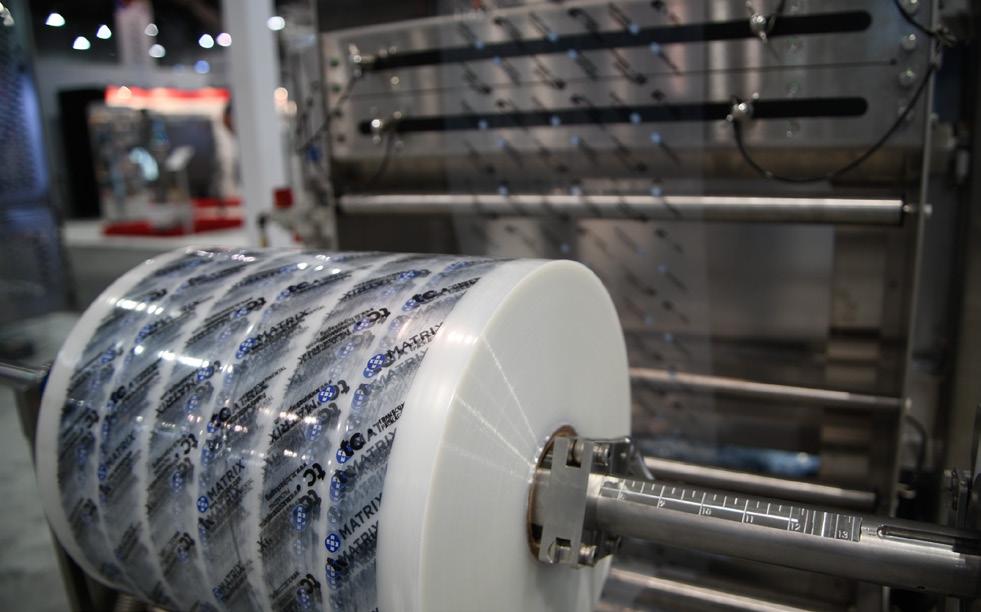
Demonstration of a liquid packaging application being performed on a Matrix rollstock vertical from-fillseal packaging machine.
into boxes for shipping than cartons or jars. More of them will fit into a box of the same size, which leads to fewer boxes, pallets and trucks needed to transport the product.
All of these small cutbacks ultimately add up to major reductions in both the material and CO2 emissions required for the goods to reach their destination.
This is especially important with the increase in e-commerce and the resulting jump in shipping needs to account for this direct-to-consumer business model.
One of the biggest advantages when it comes to saving space is found in bags having zero headspace, which refers to the absence of air within the sealed pouch.
Reducing the air in the bag means product lasts longer. Additionally, less air produces a flatter bag, enabling more bags to be packed in a case.
A flat pouch takes up remarkably little space compared to cartons and jars. This frees up shelf-space and any additional storage within the often-crowded retail environment for other uses.
The machines used to fill the pouches can also be modified to fit into an operation’s space requirements. Vertical form-fill-seal (VFFS) machinery is an attractive option for many because of its small footprint and overall versatility to run a wide variety of package styles and SKUs (stock-keeping units), thanks to fast and efficient changeovers.
Conversely, space savings is generally not a selling point of horizontal formfill-seal (HFFS) machines. But where this HFFS equipment really shines is in applications running the same product or SKU in continuous operation.
Both styles can fill liquids, with some handling a combination of solid and liquid products for added efficiency.
The space within the package is also better utilized with flexible pouches. Air bubbles are the enemy of liquid products: not only do they take up space, but they can also introduce contaminants that lead to premature spoiling.
In contrast, flexible pouches have less room for these air bubbles than rigid containers, and any air that gets in can be squeezed out before the package is sealed due to its malleable exterior.
Calling this style of packaging “flexible” can refer to more than just the material’s pliability. It can also refer to the adaptability pouches have to multiple different industries.
One area where flexibles have found a lot of success is in single-serving meal prep kits. Many of these, including salad and pizza kits, can be found in a standard grocery store, but some are strictly subscription-based, and are thus shipped food directly to the customer. In either case, this application re-
40 CANADIANPACKAGING · May 2024 CANADIANPACKAGING.COM
LIQUID PACKAGING

quires portioned out liquid ingredients, sauces or dressings in a package small enough to fit in the kit with all the other components.
Not only can the pouches be made smaller than rigid containers, but they can also be manipulated to fit into almost any space—making them an optimal choice for meal kits.
Accommodating larger quantities within a single package is another handy functionality offered by flexible pouches.
The foodservice industry has been
shifting over to this method for all the benefits listed above, along with the ease of working with a pouch for liquid goods.
The pouches are generally easier to open, and foodservice workers can easily access any product stuck in the container to squeeze out every drop.
Manufacturers using pouches also have more options for the final look of the product. A common choice for pouch packaging is using stand-up pouches for a more professional presentation of the product.
One of the key performance advantages offered by liquid pouch filling is the virtually zero headspace, which enables the sealed product to last longer due to minimal presence of air inside the pouch compared to cartons and jars.
Moreover, the film used to form the pouch can be printed with a custom design, sizing, shape and color to further accentuate the look of the package and adding extra marketing appeal to the product. While some of these options are also available in cartons and jars, it is often done at a much-reduced capacity and a higher price point.
As flexible pouching continues to grow in prevalence across Canada, so does its impact on waste reduction, warehouse efficiency and more options for both manufacturers and consumers.
All these benefits from a simple shift in packaging material make it no surprise that many industry experts predict that future of liquid packaging to be, quite literally, in the bag.


ERIK ZELLMER is the sales manager of channel partnerships for Matrix, a ProMach subsidiary.
JAIME ALBOIM is the chief executive officer of Tessera Group, Inc., Canadian-based integrator of packaging automation solutions.
PLAN AUTOMATION APPOINTMENT
Plan Automation is delighted to welcome Tom Branigan as a new Associate Partner. With over 20 years of experience as a sales leader, he is situated in the heart of Southern Ontario and will bring his expertise to the food safety inspection market. Tom’s focus is on projects in Food Safety and Quality Inspection, Processing Automation, Packaging Automation and Plant Hygiene.
“I’m incredibly excited to have this opportunity at one of the largest general automation companies in Canada. Plan Automation has top-tier support systems throughout, and the Parts & Service team is exceptional. The work environment and atmosphere at Plan Automation is excellent and I’m thrilled to be a part of the team”

Having spent half of his career in the Process world, Tom brings a unique sales perspective to Plan. He has supported new tank, pump and valve installations in Eastern Canada. Tom also ventured out into the Western Canada oils patch, overseeing Density and Viscometer installations. In Northern Ontario, he worked with Emission monitoring systems in the Pulp & Paper industry.
In 2018, Tom moved into the Industrial world as a new career challenge and excelled at Sanitary Conveyor design and implementation. Tom was recently with the multi-national firm FORTNA (merged with MHS), but the opportunity to become an Associate Partner was too exciting to pass up. In coming to Plan, he will continue to foster high-level relationships within their customer base. Tom will proactively identify potential opportunities for growth. He is excited to be a part of Plan’s aggressive growth expectations for Southern Ontario.
“I am looking forward to collaborating with my new talented co-workers at Plan. By fostering a culture of collaboration, you harness the collective strength of your team while building relationships. Fostering good relationships builds confidence, trust, and respect for each other. The clients will always come first, and I am confident in myself and our team at Plan to brainstorm innovative solutions for them.”
Outside of the workplace, Tom’s passion is spending time at the cottage with his wife and two wonderful children. Tom is an avid sports fan, plays hockey and slow pitch baseball. Tom is a part owner of the Green Bay Packers and is a long-suffering Toronto Maple Leaf fan.
Contact Tom at 416-919-2837 or tom@planautomation.com
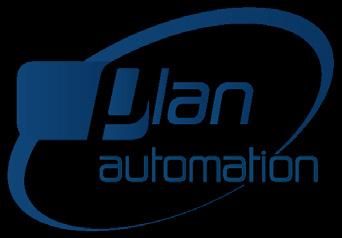
May 2024 · CANADIANPACKAGING 41 CANADIANPACKAGING.COM
CPK_Plan Automation_MAY24_GWJ.indd 1 2024-05-02 5:13 PM
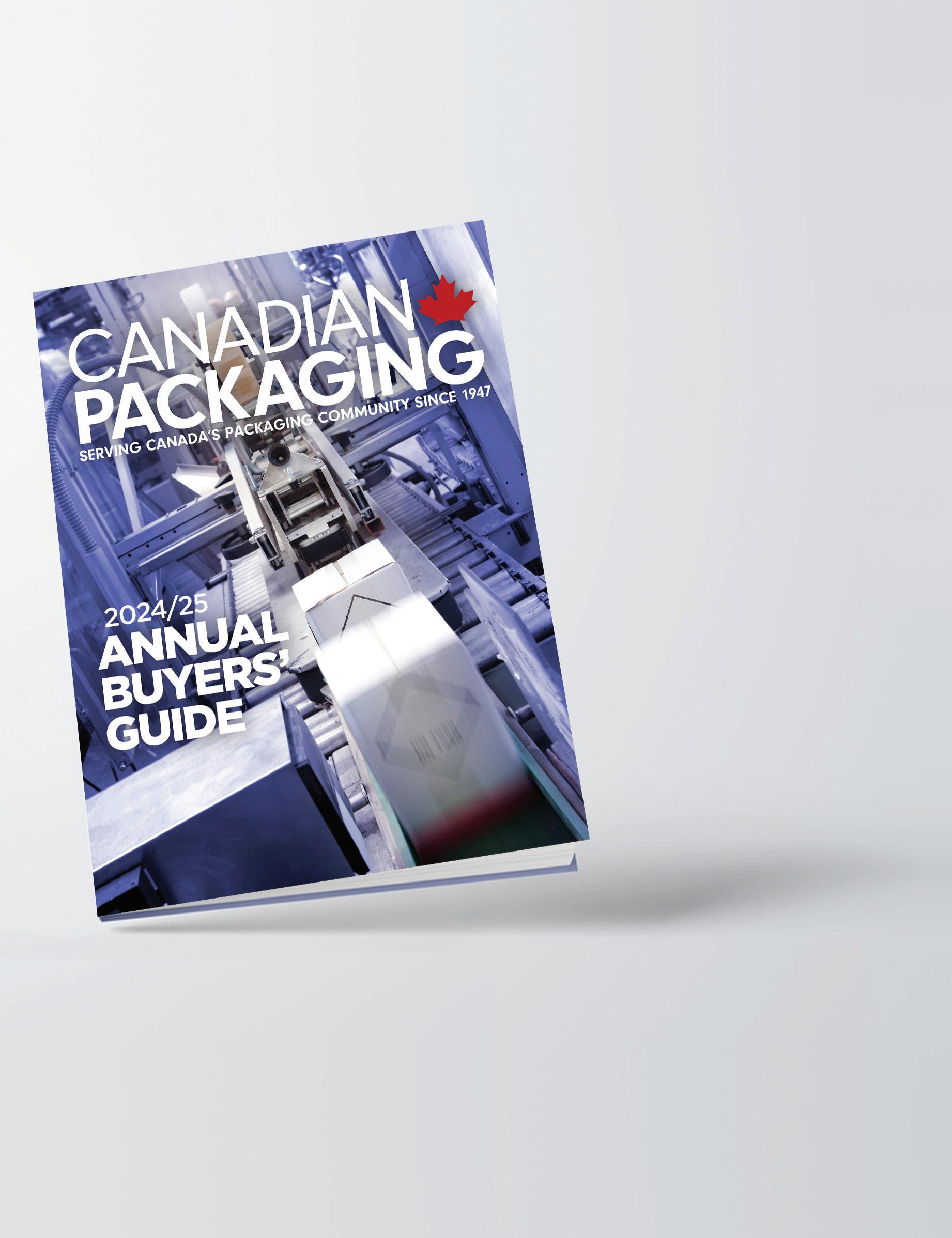
BIG OPPORTUNITY
CANADIAN PACKAGING ANNUAL BUYERS’ GUIDE AUDIENCE:
• 14,000 print copies addressed by name to Canada’s top packaging buying influences.
• Food, beverage, pharmaceutical, cosmetic, household CPG’s.
• Package converting companies.
• Digital version e-blasts to 13,000 opt-in e-audience.
BONUS: FREE listing links for Buyers’ Guide advertisers on Category Captains drop-down digital directory on www.canadianpackaging.com (Up to 6 categories)

BIG
ISSUE
Contact Stephen Dean: 416.510.5198 sdean@canadianpackaging.com The Living, Breathing Packaging Sustainability Guide Also in the guide: Living, Breathing Packaging Sustainability Guide Call for exciting details! AD CLOSING DATE: JULY 17 I AD MATERIAL DUE: JULY 25 Issue circulates mid-August

2024
MAY 15-16
Red Deer, Ab.: 2024 SmartMTX (Smart Manufacturing and Technology Exposition) , manufacturing technologies exhibition and conference for Western Canada by the Manufacturing and Export Enhancement Cluster. At Westerner Park. To register, go to: www.smartmtx.ca
MAY 28 – JUNE 7
Düsseldorf, Germany: drupa 2024, global trade fair for printing technologies by Messe Düsseldorf GmbH. At Messe D ü sseldorf fairgrounds. To register, go to: www.drupa.com
JUNE 4-6
Atlanta, Ga.: 2024 SFI Annual Conference , by Sustainable Forestry Initiative (SFI). At Loews Atlanta Hotel. To register, go to: www.sfi.swoogo.com
JUNE 20-21
Chicago: AmericaPack Summit
2024, conference by Marcusevans Group. At Radisson Blu. To register, go to: www.marcusevanscy.com
JUNE 24-25
New York City: Vinexpo America, global alcohol beverages exhibition by Vinexposium. At Jacob K. Javits Center. To register, go to: www.vinexposium.com
SEPT. 10-12
Chicago: Labelexpo Americas 2024, exhibition and conference by Informa Markets. At Donald E. Stephens Convention Center. To register, go to: www.labelexpo-americas.com
NOV. 3-6
Chicago: Pack Expo International 2024 , global packaging technologies exhibition and conference by PMMI, The Association for Packaging and Processing Technologies. At McCormick Place fairgrounds. To register, go to: www.packexpo.com
ENGINEERED FOR THE MEAT INDUSTRY
“MEAT” THE DELKOR PERFORMANCE CASE PACKER

Murray Driediger, president and chief executive officer of BC Fresh Vegetables Inc. (BC Fresh), has been named as recipient of the 2024 Lifetime Achievement Award of the Canadian Produce Marketing Association (CPMA) in recognition of his significant contributions to the fresh produce industry.

Ossid , Battleboro, N.C.-based ProMach subsidiary specializing the manufacture of tray-packing and thermoform form/fill/seal machinery for the fresh protein, produce, seafood, bakery, and medical device industries, has appointed Bret Inskip as regional sales manager for the upper mid-west U.S. region.
St. Louis, Mo.-headquartered packaging machinery manufacturing group Barry-Wehmiller has appointed George Bergas as vice-president of the company’ global supply chain operations.

KM Packaging , U.K-headquartered supplier flexible packaging and lidding films, has appointed Mike Aho as business leader of the company’s North American operations.
Mississauga, Ont.-based safety sensors distributor Pilz Automation Safety Canada L.P., has announced that its long-time CEO and general manager Andreas Sobotta has been appointed as vice-president for North and South America for the parent comapny Pilz GmbH & Co. KG’s global business.


Ken Liu, chief executive officer of paper products manufacturer NP Paper , U.S. subsidiary of Hong Kong-based Nine Dragons Paper (Holdings) Limited, has been named as the Executive of the Year by TAPPI/ PIMA , leading global pulp and paper industry associations.

• Total wash-down with an IP69 rating
• Contoured infeed system
• Intelligent synchronization
• High speed pick & place

If you’re looking for speed and hygiene, we have the case packer for you. Please contact our Canadian market specialist Matt Meidl at mmeidl@delkorsystems.com
May 2024 · CANADIANPACKAGING 43 CANADIANPACKAGING.COM
CPK_DELKOR_APRIL24_BAS.indd 1 2024-05-02 3:10 PM
EVENTS
PEOPLE
Time to wake up and smell new coffee packaging options / Jaan Koel
As the world’s most popular beverage, coffee carries many faces in many places. In fact, ever since its discovery centuries ago by a goat herder on the plains of Ethopia, coffee has become the second most sought-after commodity on the planet, second only to crude oil. Nturally, such widespread global appeal has led to creation of a myriad of packaging and preparation formats, including the often underrated instnt coffe. Despite its convenience, instant coffee is generally regarded as inferior to its freshly brewed counterparts. But there are some upscale offerings that come pretty close to evening the score. A good case in point is the Via Instant 100% Arabica and Microground Coffee from the global coffee powerhouse Starbucks. The product comes in small 3.3-gram individual polyfoil tube-like sachets that measure roughly 10x2-cm, making them easy to pinch and tear open between the thumb and forefinger. There are eight sachets to the pack, which is a small paperboard standup pouch that is attractively designed and printed, with the familiar dark-green Starbucks logo prominently displayed on the pack. According to Starbucks, the Microground instant coffee is made by grinding high-quality roasted beans into a fine powder, which is then packaged into individual single-serve sachets that deliver exceptional taste, aroma, and convenience.
When it’s time for some top-drawer filtered coffee, you need to look no further than the Chemex Coffeemaker from Chemex Corporation of Chicopee, Ma. It is an integrated system that combines proprietary paper filters with an hourglass-shaped carafe, where the glass filter basket flows seamlessly into the glass container below. The waist-like section of the hourglass vessel sports an attractive two-part wooden insulation collar held together by a leather cord. Invented by Peter Schlumbohm in 1941, the Chemex Coffeemaker was selected as “one of the best-designed products of modern times” by the Illinois Institute of Technology back in 1958. Moreover, it is also lauded as a piece of art as much as a useful kitch-


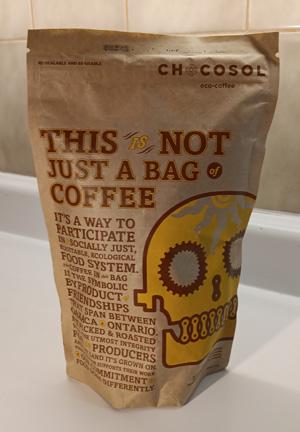
The classic Chemex Coffeemaker home brewing system.
The paperboard stand-up pouch and single-serve sachet of Starbucks Via Instant brand coffee.
The ‘This is not just a bag of Coffee’ brand made by Chocosol Traders.
The brick-shaped 250-gram pack of the Lavazza ORO brand coffee.
The high-end Bulletproof coffee brand certified by the Rainforest Alliance.
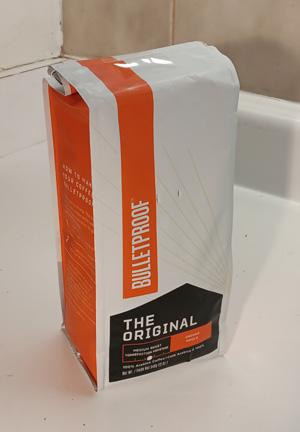

en appliance, considering it is on permanent display at the revered Museum of Modern Art in New York City. While the Chemex brand paper filters—both bleached and unbleached—are 20 to 30-percent heavier than most other paper filters in the market, they do an amazing job of removing even the finest sediment particles, while facilitating proper infusion time by regulating the filtration rate.
Look no further than to Lavazza of Torino, Italy, for top-quality ground coffee that, in its smallest 250-gram offering, is packed in brick-shaped plastic-foil units bearing remarkable resemblance to Tetra Pak beverage cartons. This Lavazza brand size is the one consumers see most often on the store-shelves—offering premium quality at a competitive price— as the brick-like shape offers significant cost savings in shipping and logistical benefits in merchandising.
The word “bulletproof” usually refers to glass, protective vests and irrefutable arguments, but it also has a connection to coffee as well. Also knows as s butter coffee or keto coffee, Bulletproof is a blend of high-quality coffee, MCT oil, and ghee (butter) that proponents claim offers sustained energy, increased satis-
faction, and improved brain power. And a lot of people swear by it. The MCT oil is claimed to be easier to digest than most other oils because it enters the bloodstream quickly, providing a burst of energy and a feeling of well-being. People also use MCT oil for help with weight loss, appetite control, and inflammation. Produced by Bulletproof Inc. of Seattle, Wa., the trademarked Bulletproof coffee comes in a crisp, laminated rectangular package with distinctive typography and orange-and-black coloring matching the firm’s many other products. The company uses its own proprietary Bulletproof Clean Coffee Process to make the product, and partners with growers through the Rainforest Alliance to ensure its beans are produced using sustainable harvesting methods that support local communities and utilize climate-smart agricultural techniques.
During a recent visit to Evergreen Brickworks Park in Toronto with java on my mind, I strolled into the Garden Market outlet, where I couldn’t help but notice a large kraft paper/poly stand-up pouch with the words “This Is Not Just a Bag of Coffee” emblazoned on the front. The colors are fairly simple—yellow and brown on beige background— with a stylized image of what looks like a skull, consisting of sprockets for eyes and a bicycle-chain mouth, quickly drawing attention to itself. Next to the skull is a feel-good message about the product being symbolic of friendships that span between Oaxaca, the region in Mexico where the beans are from, and Ontario, where the beans are roasted and sold by Toronto-based Chocosol Traders in a “re-sealable and re-usable” pouch packing 550-mg of potassium, 50-mg of calcium, and 5.5 mg of iron for per each half-cup of the nutrient-rich brew for a super healthy pick-me-up to start the day on a front foot.

44 CANADIANPACKAGING · May 2024 CANADIANPACKAGING.COM CHECKOUT
JAAN KOEL is a freelance writer and jazz musician living in Toronto.
Clockwise from left
AC&E North America Inc. 37 Beneco Packaging 39, OBC Busch Vacuum Technics Inc. 2 Canadian Packaging 42 Delkor Systems Inc. 32, 43 Harlund Industries Ltd 11 Heat and Control IFC mk North America 6 mmb media agentur gmbh (KHS) 9 Multivac Canada Inc. 7 Plan Automation 10, 41 Reiser / Robert Reiser & Co. 5 Rychiger Canada Inc., O/A Nuspark IBC Shawpak Systems 22, 34 Technical Adhesives Limited 27 Uline Canada Corporation 8 VC999 Packaging 12 Videojet Canada 1 AD INDEX
Rychiger Rychiger, Ree...hee...ger.




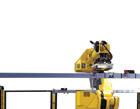


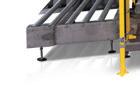

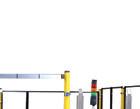





Nuspark is now RYCHIGER and together we offer extensive expertise with over 125 years of combined experience. As part of the Rychiger Group we are able to craft cutting-edge solutions from primary, secondary, and tertiary packaging.
Rychiger, is now the only name you need to know when it comes to automated packaging equipment solutions for the food & beverage, pharmaceutical, and personal care industries.
www.rychiger.com
Leader in packaging automation solutions Make it smarter




































































































 Vlad Rebellon Sr. Director, Loblaw Brands
Vlad Rebellon Sr. Director, Loblaw Brands
 Tom Szaky Founder & CEO, Terracycle & Loop
Tom Szaky Founder & CEO, Terracycle & Loop
 Kent Wootton Manager of Circular Materials Innovations Canadian Tire Corporation
Kent Wootton Manager of Circular Materials Innovations Canadian Tire Corporation



































































































